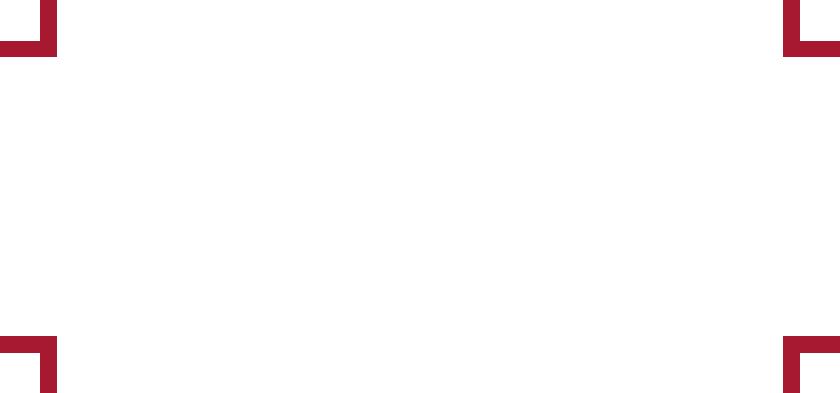
Welcome to the Oct 11th, 2023 issue
of Radio World
meow

Well...not really. Our LiON has the latest Wheatstone DSP algorithms; it is not a 90’s era processor by any means. The AUDIOARTS LiON Five-Band Processor/Multipath Controller has WheatNet-IP, so it can be networked. It has analog and AES3 so it can stand alone. It has Wheatstone SystemLink™ built in, to send full 24-bit linear audio directly to your transmitter over reliable high-speed links — Baseband 192 MPX with FM+HD timing locked (no codec to degrade audio quality). And it comes with 50 presets so you can plug and play. Let your signal ROAR on a kitten budget!



SO...what’s really in the box?
ALL SIGNAL PATHS
• Analog, AES3 and Wheatnet-IP audio


• AES3 input accepts 32kHz to 96kHz sample rates


• Variable high pass filter and voice phase rotator
• Dynamic L/R correlation meter for proper stereo channel phase
• Front panel setup
• PC-based GUI included
• Ethernet-based remote control

• Four-band equalizer: low/high shelf plus two-band parametric
• User-adjustable multiband crossover frequencies

• Independent multiband compressor and leveler can be operated separately or in combination
• Multiband spectral manager
• Newly developed bass management
• High-performance low distortion multiband limiters
• Metering for all input and output levels and dynamics processing

FM PATH
• New distortion-masked FM peak clipper
• Specialized live voice algorithm minimizes vocal distortion
• Exclusive stereo multipath controller
• RDS/RBDS generator, static and dynamic

• Precision FM stereo MPX generator with multiplex mask filter
• Baseband192 built in for 192kHz digital MPX link to transmitter
• Support for ITU.BS-412 MPX

• Ten seconds of FM/HD diversity delay
• Test oscillator
HD/STREAM PATH
• Low/high shelf plus two-band parametric equalizer
• HD/Stream final processing accepts audio from unprocessed input, output of AGC, or output from multiband limiters




• Oversampled precision look-ahead limiters for exceptional final peak control

• Specialized dynamic high frequency protection for low bitrate codecs; also operates in wideband (>12kHz) and <12kHz modes



• ITU-BS.1770 loudness metering and controller

Manufactured in North Carolina USA
hear your station online.



Hams worry about shortwave proposal
Strong pushback over a plan from financial traders.
A simpler
way
to proof antennas
Gregg Skall reviews the recent rule change allowing computer-modeled proofs of FM DAs.
Youthful enthusiasm
A new program seeks to nourish interest in radio among high school students.
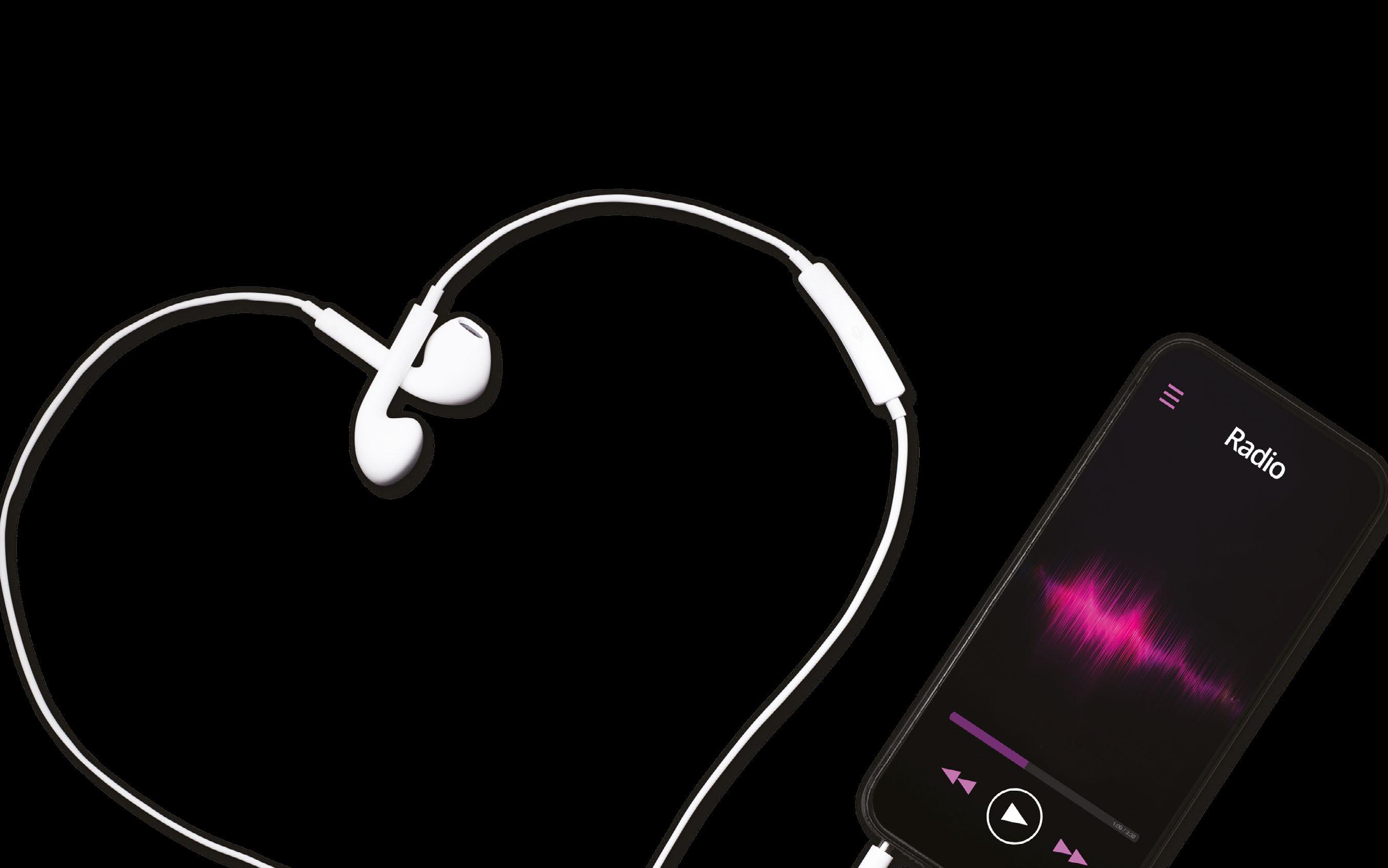

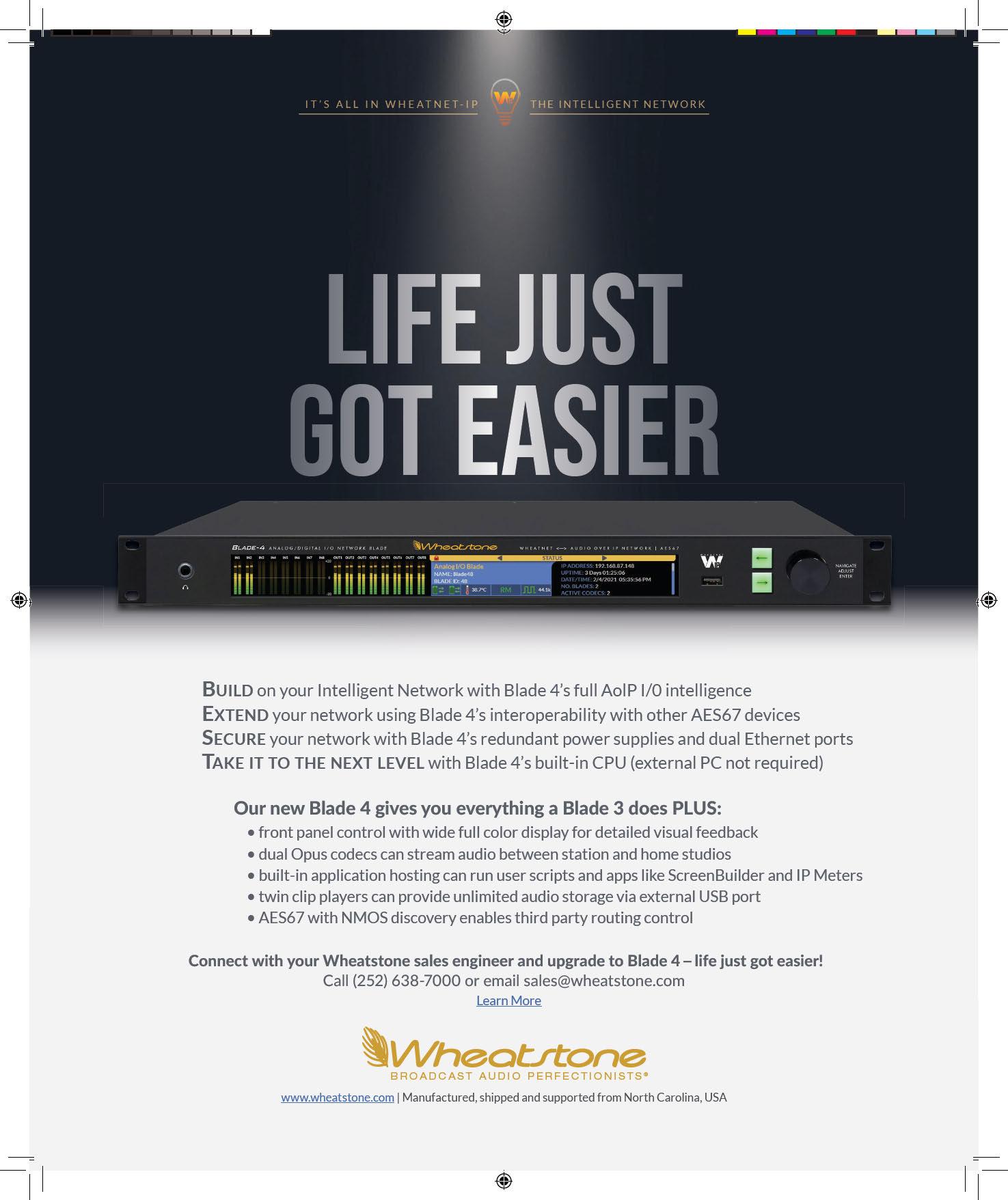
Vol.
47
FOLLOW US
www.twitter.com/radioworld_news
www.facebook.com/RadioWorldMagazine www.linkedin.com/company/radio-world-futureplc
CONTENT
Managing Director, Content & Editor in Chief Paul J. McLane, paul.mclane@futurenet.com, 845-414-6105

Content Producer & SmartBrief Editor Elle Kehres, elle.kehres@futurenet.com
Technical Advisors Thomas R. McGinley, Doug Irwin Technical Editor, RW Engineering Extra W.C. “Cris” Alexander
Contributors: Susan Ashworth, David Bialik, John Bisset, Edwin Bukont, James Careless, Ken Deutsch, Mark Durenberger, Charles Fitch, Donna Halper, Alan Jurison, Paul Kaminski, John Kean, Nick Langan, Larry Langford, Mark Lapidus, Michael LeClair, Frank McCoy, Jim Peck, Mark Persons, Stephen M. Poole, James O’Neal, T. Carter Ross, John Schneider, Gregg Skall, Dan Slentz, Dennis Sloatman, Randy Stine, Tom Vernon, Jennifer Waits, Steve Walker, Chris Wygal
Production Manager Nicole Schilling
Group Art Director Nicole Cobban
Senior Design Director Lisa McIntosh
Senior Art Editor Will Shum
Art Editor Cliff Newman
ADVERTISING SALES

Senior Business Director & Publisher, Radio World John Casey, john.casey@futurenet.com, 845-678-3839
Publisher, Radio World International Raffaella Calabrese, raffaella.calabrese@futurenet.com, +39-320-891-1938
SUBSCRIBER CUSTOMER SERVICE
To subscribe, change your address, or check on your current account status, go to www.radioworld.com and click on Subscribe, email futureplc@computerfulfillment.com, call 888-266-5828, or write P.O. Box 1051, Lowell, MA 01853.
Licensing/Reprints/Permissions
Radio World is available for licensing. Contact the Licensing team to discuss partnership opportunities. Head of Print Licensing Rachel Shaw licensing@futurenet.com
MANAGEMENT
SVP Wealth, B2B and Events
Sarah Rees
Managing Director, B2B Tech & Entertainment Brands Carmel
Managing Vice President of Sales, B2B Tech Adam Goldstein
Head of Production US & UK Mark Constance
Head of Design Rodney Dive
FUTURE US, INC.
A respected consultant retires
Laura Mizrahi steps aside at Communications Technologies
Future’s 2022 B2B Publication of the Year THIS ISSUE NEWS
King
Mizrahi began her career as a consultant in 1986, when she started working with Clarence Beverage, founder of Communications Technologies Inc. In the beginning she spent a great deal of time drawing radials onto topographic maps to be used by contract engineers doing field strength measurements for AM stations and extrapolating graphed readings into AM proof of performance applications.
3
3
Future US LLC, 130 West 42nd Street, 7th Floor, New York, NY 10036
All contents ©Future US, Inc. or published under licence. All rights reserved. No part of this magazine may be used, stored, transmitted or reproduced in any way without the prior written permission of the publisher. Future Publishing Limited (company number 02008885) is registered in England and Wales. Registered office: Quay House, The Ambury, Bath BA1 1UA. All information contained in this publication is for information only and is, as far as we are aware, correct at the time of going to press. Future cannot accept any responsibility for errors or inaccuracies in such information. You are advised to contact manufacturers and retailers directly with regard to the price of products/services referred to in this publication. Apps and websites mentioned in this publication are not under our control. We are not responsible for their contents or any other changes or updates to them. This magazine is fully independent and not affiliated in any way with the companies mentioned herein.
If you submit material to us, you warrant that you own the material and/or have the necessary rights/ permissions to supply the material and you automatically grant Future and its licensees a licence to publish your submission in whole or in part in any/all issues and/or editions of publications, in any format published worldwide and on associated websites, social media channels and associated products. Any material you submit is sent at your own risk and, although every care is taken, neither Future nor its employees, agents, subcontractors or licensees shall be liable for loss or damage. We assume all unsolicited material is for publication unless otherwise stated, and reserve the right to edit, amend, adapt all submissions.
Radio World (ISSN: 0274-8541) is published bi-weekly with additional issues in February, April, June, August, October and December by Future US, Inc., 130 West 42nd Street, 7th Floor, New York, NY 10036. Phone: (978) 667-0352. Periodicals postage rates are paid at New York, NY and additional mailing offices.
“Thankfully, much of this type of work is either now automated ... or eliminated,” she told Radio World’s Elle Kehres. Mizrahi recalls all too clearly the many paper, handtyped, notarized applications and the need for multiple copies to be overnighted to the FCC to meet short filing deadlines. “I do not miss those days at all!”
While the firm works across all broadcast segments, Clarence Beverage is best known for his AM antenna design work while Mizrahi’s focus evolved to be on FM and FM translators with a specialty in noncommercial stations LPFM. Beverage became a mentor and, eventually, her husband.
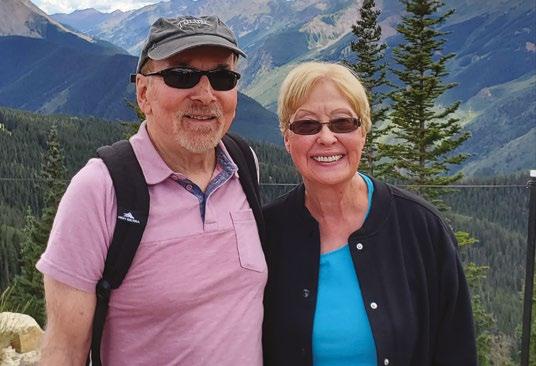
When asked about important trends in radio technology, Mizrahi noted the FCC’s proposal to allow FM stations to increase HD power level to 10 percent of the analog power level. “This opportunity could convince more stations to adopt HD operation and would potentially lead to the day when FM will become an all-digital platform, which will allow additional ancillary program channels to be added,” she said.
You can read our profile article at http://radioworld.com, keyword Mizrahi.
Left Clarence Beverage and Laura Mizrahi
No.
Please recycle. We are committed to only using magazine paper which is derived from responsibly managed, certified forestry and chlorine-free manufacture. The paper in this magazine was sourced and produced from sustainable managed forests, conforming to strict environmental and socioeconomic standards. October
25 |
11 2023
www.radioworld.com
aura Mizrahi is retiring after more than 35 years as a technical consultant, and broadcasters in the United States are losing an ally as a result.From the Editor 4 Newswatch
Hams worry about shortwave proposal FEATURES
This is
tower
An
proof antennas
7 tips
streaming
rebuilds at West Pines
New program nourishes high school interest in radio 26 Trust me, I’m AI OPINION
That’s a cool tower 30 Readers’ Forum
POSTMASTER: Send address changes to Radio World, PO Box 1051, Lowell, MA 01853.
5
10
one
climber you don’t want to see 13
easier, simpler way to
18
for better
21 Midwest
22
29
L
Paul McLane Editor in Chief
Budget Boost Has Helped With Pirate Enforcement
Chairwoman Jessica Rosenworcel said the FCC’s work against pirate radio has been boosted significantly thanks to implementation of the Pirate Act, which became law in 2020.
Speaking in September to the Senate Appropriations Subcommittee about the FCC’s FY24 budget request, Rosenworcel said pirate enforcement has been aided by a subsequent $5 million budget increase to the FCC’s base appropriation.
“At the current spending level approved by this subcommittee, we will be able to continue this important work.”
She noted that in addition to tougher fines, the law requires the FCC to conduct periodic enforcement sweeps and grants it authority to take action against landlords and property owners that permit illegal radio activity on their properties.

In March the FCC proposed a record fine of more than $2.3 million against two men for alleged pirate activities in New York City. In 2023 so far, the agency also has issued 24 notices to property owners warning them of apparent broadcasts from their properties.
In its budget request, the FCC sought $410.7 million for fiscal 2024, an increase of about 5.3% from the 2023 appropriated level. The
request would pay program expenses and salaries of 1,600 full-time staff. The FCC is a feefunded agency and collects most of its budget through regulatory fees.
In her testimony Rosenworcel mentioned the FCC’s recent decision to tweak its methodology for calculating those fees, something that had been sought by the NAB. She said the change “aligns the assessment of regulatory fees more closely with the burden of the work being performed by commission employees in each category.”
Separately in September, the FCC announced that John Gabrysch of the Media Bureau won the 2023 Excellence in Engineering award “for his outstanding work in developing innovative tools and methodologies for analyzing interference in the AM radio service,” according to a press release. The commission said Gabrysch’s efforts have had a “significant impact” on its decision-making process for licensing AM stations.
“His work will allow the commission to work more efficiently and will benefit the radio industry by accelerating the approval of AM filings and ensure AM stations provide the best service to their listeners,” said the FCC.
4 Newswatch
Writer Randy J. Stine

Hams worry about shortwave proposal
The U.S. Coast Guard also is concerned about petition from the Shortwave Modernization Coalition
Numerous commenters have told the FCC that a proposal to “modernize” the shortwave band is a threat to amateur radio operators in the United States and possibly the end of ham radio as we know it. And hams are just one source of opposition to the idea.
The FCC inquiry was prompted by a request from the Shortwave Modernization Coalition for a rulemaking to amend the Part 90 rules.
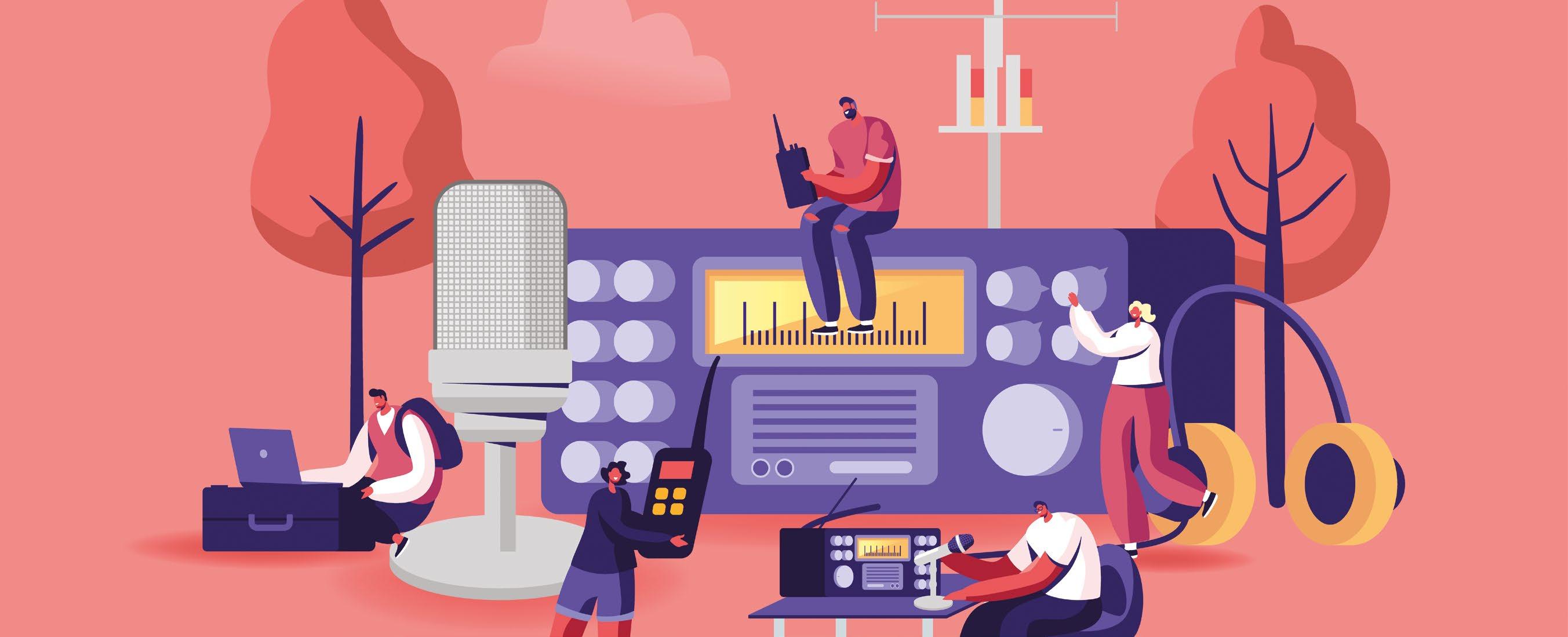
SMC believes there is underutilized spectrum in the high-frequency bands. The coalition wants to use 20 kW transmitters for the transmission of time-sensitive data from fixed stations. It wants the FCC to allow these fixed, long-distance, non-voice communications in multiple bands between 2 MHz and 25 MHz.
Ham opponents worry about interference. One also characterized the coalition as being “packed with special interest groups that harbor little interest in shortwave modernization beyond their own needs to getting faster financial market information.”
The commission’s Office of the Managing Director sought comments on its proposal this summer. The petition, RM11953, drew more than 800 comments.
“Significant” interference
Financial traders have been using shortwave links for several years under experimental licenses granted by the
FCC to send data between U.S. and foreign exchanges in the band’s Industrial/Business Pool frequencies. The coalition seeks a permanent solution including business licensing of commercial activities.
The proposal would prohibit voice transmission and mobile operations. But while it excludes amateur bands, it does involve high-power operations on spectrum adjacent to frequencies used by the Amateur Radio Service, according to people watching the issue.
Opponents say this would put hundreds of thousands of licensed American amateur radio operators at risk of receiving interference, while SMC believes any interference would be significantly below the noise floor.
Some commenters also said the petition fails to provide complete disclosure of the actual effective radiated power of those 20 kW transmitters, which they say could exceed 200 kW thanks to antenna gain.
The National Association for Amateur Radio, also known as the American Radio Relay League or ARRL, called the proposal seriously flawed.
“Many of the subject Part 90 bands are immediately adjacent or very near to spectrum bands that are allocated to the Amateur Radio Service on a primary basis,” it wrote.
“These bands are very heavily used for worldwide communication by amateur radio licensees employing significantly less power than that proposed by SMC for purposes that include vital support during disaster recovery
invincible_bulldog/Getty Images 5 radioworld.com | October 11 2023 Shortwave Radio
The author wrote here recently about the upcoming low-power FM application window.
and mitigation, technical and scientific experiments, and propagation studies.”
ARRL says its laboratory conducted a detailed technical review over several months to determine if the proposed rules would affect radio amateurs.
“ARRL’s analysis determined that, if the proposed rules are adopted, the new operations inevitably will cause significant harmful interference to many users of adjacent and nearby spectrum, including amateur radio licensees.”
AARL adds: “SMC also proposes to substantially lessen the protections required to protect adjacent and neighboring licensees … using digital schemes with 50 kHz bandwidths and 20,000 watts of power.”
Hundreds of licensed amateurs filed comments in the docket, expressing overwhelming opposition for various reasons.
“Frequent solar emissions introduce noise in the shortwave bands that will likely interfere with these proposed signals, making them unusable for the purpose of reliably providing high-speed transmission of financial data,” wrote ham Robert Kirkland Smith. “I think the coalition would be better served to stay with the more secure and noise-resistant means of fiber-optic systems for their data transmission needs.”
Another commenter from the amateur community said the FCC’s ability to track and solve any possible interference issues is severely lacking.
“The commission is already overtaxed to resolve a variety of spectrum interference complaints from a variety of existing users,” wrote Lee F. Ilse. “Given that the requested authorization for higher-power transmissions is virtually guaranteed to cause additional interference, I respectfully suggest it would be highly irresponsible for the commission to adopt the suggested changes without a significant increase in resources dedicated to enforcement.”
Longtime ham Joseph Lee McLaughlin told the FCC: “Radio amateurs will encounter considerably more difficulty communicating over these bands. The effect of spurious emissions and interference from the high-power digital transmissions … exhibit a moderate level of harmful interference to most amateurs who use the portions of the radio spectrum adjacent to these transmissions,” he wrote.
“The most harmful interference will occur with marginal operators and marginal operating conditions such as longdistance, transcontinental and DX operations.”
One commenter suggested using a “guard band equal [to] or greater than the transmission bandwidth between the edge of the signal and the edge of the land mobile band.” Another veteran ham said the 20 kW power suggested by SMC “is truly overkill for digital signals.”
“Force multiplier”
There are others who took aim at the financial companies in the coalition, citing ethical concerns.
“The question before the commission is whether this proceeding really serves a public interest or merely enables a very small number of individuals and firms to further enrich themselves at the expense of consuming actual bandwidth and raising the noise floor of adjacent bandwidth. I am inclined to think the public interest is not well served in this case,” wrote Frederick L. Stiles.
Then there is the public service aspect of ham radio, a core value for many amateurs.
“Ham operators are more than just hobbyists, we serve as a force multiplier for emergency communications in the event of emergencies,” wrote Cian McCarron.
“We serve in communities throughout the U.S. and every tool at our disposal is important, including the very airwaves we use. We are also instrumental in the development of new technologies that help push the boundaries of communication and we are already limited in our bandwidth, not just by our own licensee levels, but by that which is allocated to us, something we must protect to the best of our abilities.”
One community radio advocate thinks there has been an overreaction to the possibility of interference. REC Networks told the FCC the plan is “ambitious” but would not “steal” spectrum from hams.
“For nearly a century, stations in the HF spectrum, including those with power and bandwidth that are equal or exceeding what SMC is proposing, have been operating in their appropriately allocated bands without interference to users of the HF spectrum in other bands and modes,” REC stated in its comments.
“The conspiracies raised by some members of the ARS community are more tied to their political opposition to the financial and technology industries than cemented in daily practice and the International Radio Regulations.”
Nevertheless, REC opposes the petition, because “when all else fails, HF spectrum is available for emergency
“
” 6 radioworld.com | October 11 2023 Shortwave Radio
ARRL’s analysis determined that … the new operations inevitably will cause significant harmful interference to many users of adjacent and nearby spectrum, including amateur radio licensees.

Shortwave Radio
communications in order to relay information to/from an area affected by an emergency, answer calls of distress and to assure the health and welfare of any person who is physically located in an affected area in the aftermath of a natural or man-made disaster.”
Skywave Networks, a shortwave radio technology company, told the FCC it sees tremendous potential in the productive use of shortwave for long-distance, specialized, data transfer and supports the commission’s efforts to open eligibility. However, “the commission must carefully consider an appropriate regime for the licensing of the 2–25 MHz band, including smaller limits on bandwidth and greater protections for co- and adjacent-spectrum users,” the company wrote.
SMC argues that its proposed amendments to highfrequency rules would enhance the ability of users to quickly access “real-time financial data and continue to act in a manner to improve asset prices, to the benefit of centralized markets and market participants.”
Speaking out
The firms that make up the coalition are “market makers and liquidity providers” for exchanged-traded financial instruments. The coalition includes DRW Holdings, IMC Trading Group, Virtu Financial Inc., NLN Holdings, Optiver Services and Tower Research Capital.
The coalition believes that its changes also have the potential to spur additional innovations in the use of the 2–25 MHz Band frequencies. The petition claims it will be possible for their operations to coexist with other band licensees and said its own technical study supports that.
But it’s not just hams that have expressed concerns.
The United States Coast Guard, the principal federal agency responsible for maritime mobility, safety and security, told the FCC that the Maritime Mobile Service or MMS is used extensively in multiple bands between 2 MHz and 25 MHz, and important for communications that go beyond line-of-sight.
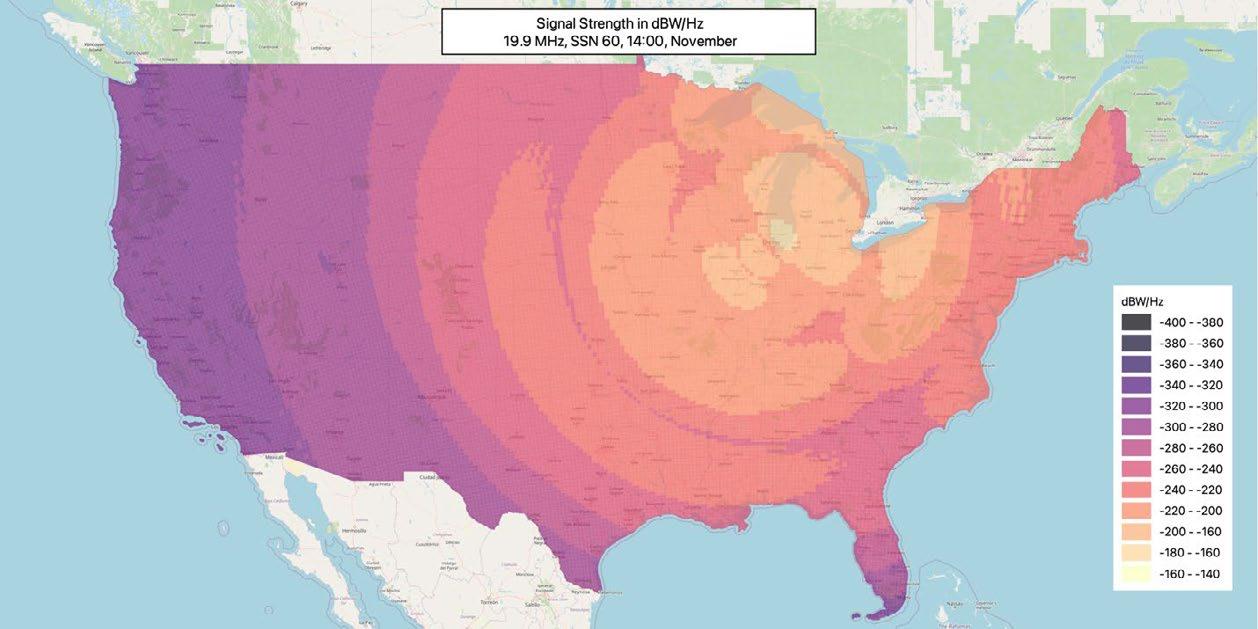

In its opposition, the USCG said the proposed new data service will likely result in a “high use percentage as the market makers and liquidity providers update their bid/ask price continuously based on the most up-to-date information.”
The Coast Guard is also concerned about cybersecurity issues “such as spoofing or jamming” that could cause interference with MMS.
NCTA–The Internet & Television Association told the commission that cable providers use 2–25 MHz for broadband and television services. It worries about disruption and degradation to those services, which they say the coalition doesn’t mention, and would make the band inhospitable for current users.
It said one experimental licensee already disrupted commercial broadband and video service. “Comcast has directly experienced multiple occurrences of service disruption from one member of petitioners’ coalition,”
Above Signal strength examples from a technical study on band coexistence submitted by the SMC with its petition.
the NCTA wrote, “caused by the exact type of operations petitioners are proposing here as a new licensed service.”
- 16
- 16 -
NTCA continued: “Each disruption resulted in customers experiencing packet loss, increased latency, slower and spotty broadband internet service, video channel changes and the inability to utilize certain Comcast devices with their services. This kind of disruption can also cause significant degradation to VoIP calls, including potentially for 911 calls.”
NCTA goes on to detail a disruption in the Seattle area in 2022 and another in a more rural part of Washington state this year.
And an extensive filing in opposition was submitted by Alex Pilosov, founder and president of Shortwave Solutions. Pilosov presented detailed data and exhibits criticizing the coalition’s request.
He says he is a consultant for a non-coalition company and that he manages system design and construction of an operational system that he described as the fastest operational HF connection on the Chicago-London route.
“Importantly, this lower-latency system operates with a spectrum efficiency that is over 1,000 times better than what the petition is seeking,” Pilosov writes.
He says the coalition’s request “is premature, incomplete and poorly thought out, and against the public interest,” and that its “lack of substance is matched by its audacity.”
Pilosov concluded: “(The) coalition’s petition is extraordinary in its scope, and if granted, would result in loss of spectrum availability worldwide, turning the critical Fixed Service spectrum into a CB-radio free-for-all loudness contest.”
the southwestern U.S., but it is weaker in the central U.S. and the south. By contrast, in Figure 15 the signal is weaker in western U.S., and stronger in the central and southern U.S. where the Figure 14 signal was the weakest. The impact of the transmit antenna pattern also is visible around Chicago in both figures with stronger signal to the northeast where the antenna main beam is directed and noticeable nulls to the northwest and southeast.
Figure 14 – Signal strength example, Chicago transmitting east Figu
-
was the weakest. The impact of the transmit antenna pattern also is visible around Chicago in both figures with stronger signal to the northeast where the antenna main beam is directed and noticeable nulls to the northwest and southeast.
Figure 14 – Signal strength example, Chicago transmitting east
8 radioworld.com | October 11 2023
Figure 15 – Signal strength example Chicago transmitting east
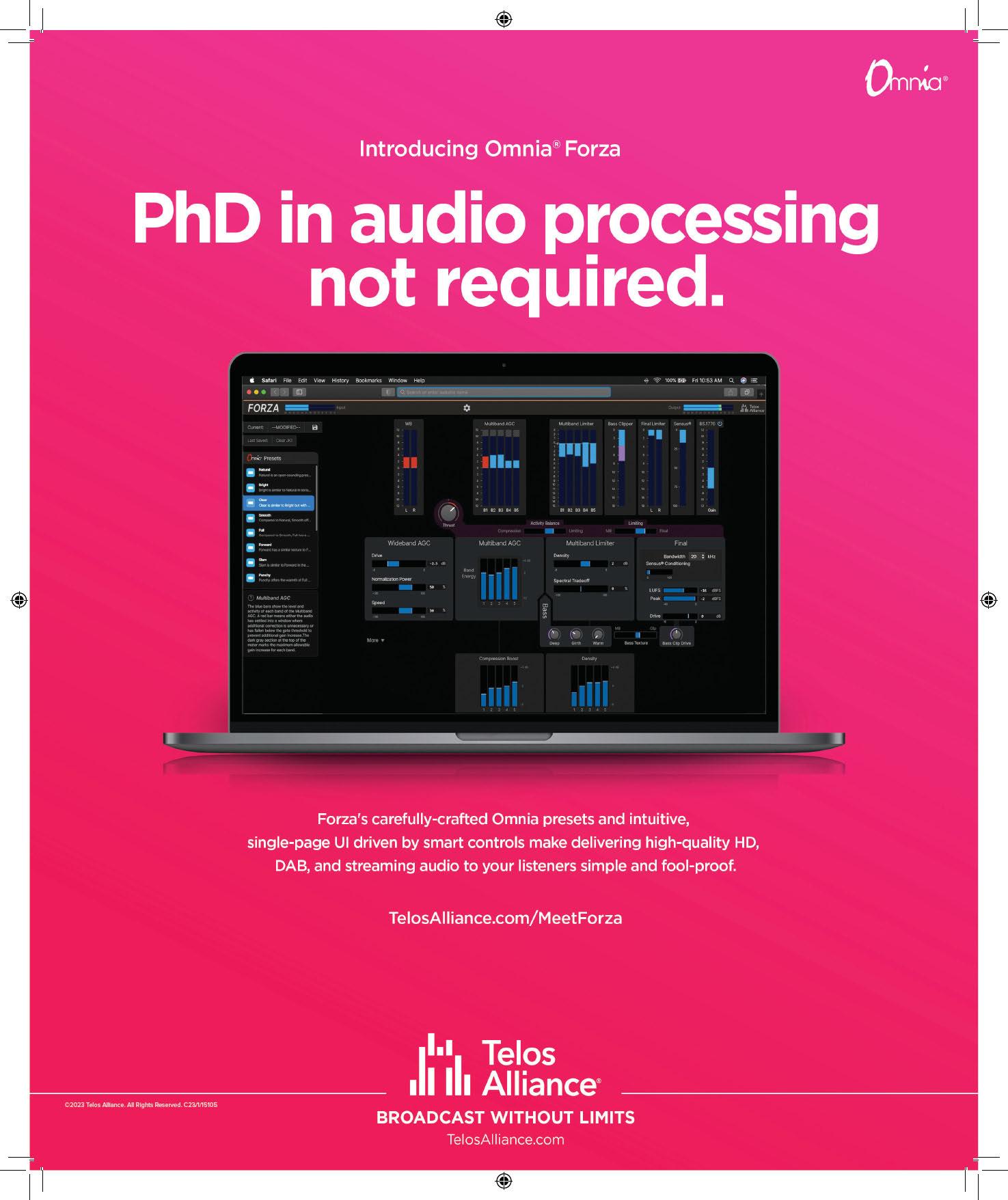 John Bisset
John Bisset
The author is in his 33rd year of writing Workbench. He handles western U.S. radio sales for the Telos Alliance and is a past recipient of the SBE’s Educator of the Year Award. Feed the grapevine Workbench submissions are encouraged and qualify for SBE recertification credit. Email johnpbisset@ gmail.com.
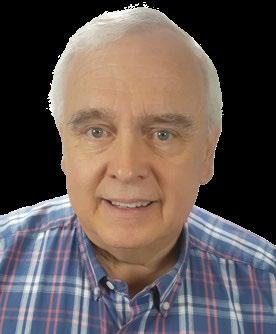
This is one tower climber you don’t want to see
It works fast (and that’s not a good thing)
If you don’t live in the southern United States you may not have had to deal with kudzu (yet).
According to the Nature Conservancy, kudzu is a semi-woody vine that was brought to the United States from Asia in 1876 as an ornamental, and it was used during the 1930s to ’50s for erosion control.
That was a mistake.
“Known as ‘mile-a-minute’ and ‘the vine that ate the South,’ this creeping, climbing perennial vine terrorizes native plants all over the southeastern United States and is making its way into the Midwest, Northeast and even Oregon,” the organization states on its website.
The accompanying photo shows kudzu at work and offers a great example of why you need to inspect your tower sites regularly.

I’m curious how this AM station stays on the air when it rains, as the vine surely has grown right across the base insulator.
Helpful Pi
KRYZ(LP), a community station in Mariposa, Calif., secured its transmitter site network from hackers using three Raspberry Pi devices and technology from Atsign, a network services provider.
“The move to Atsign came after the station’s network programming was mysteriously switched to a Swedish radio station feed playing Scandinavian rock,” Atsign said in a release. The disruption took the radio station several hours to correct.
“Atsign and KRYZ worked together to implement a security solution that closes all of the tower’s network
CPBE
Right
10 radioworld.com | October 11 2023 Workbench
Kudzu, the towerclimber that ate the South.
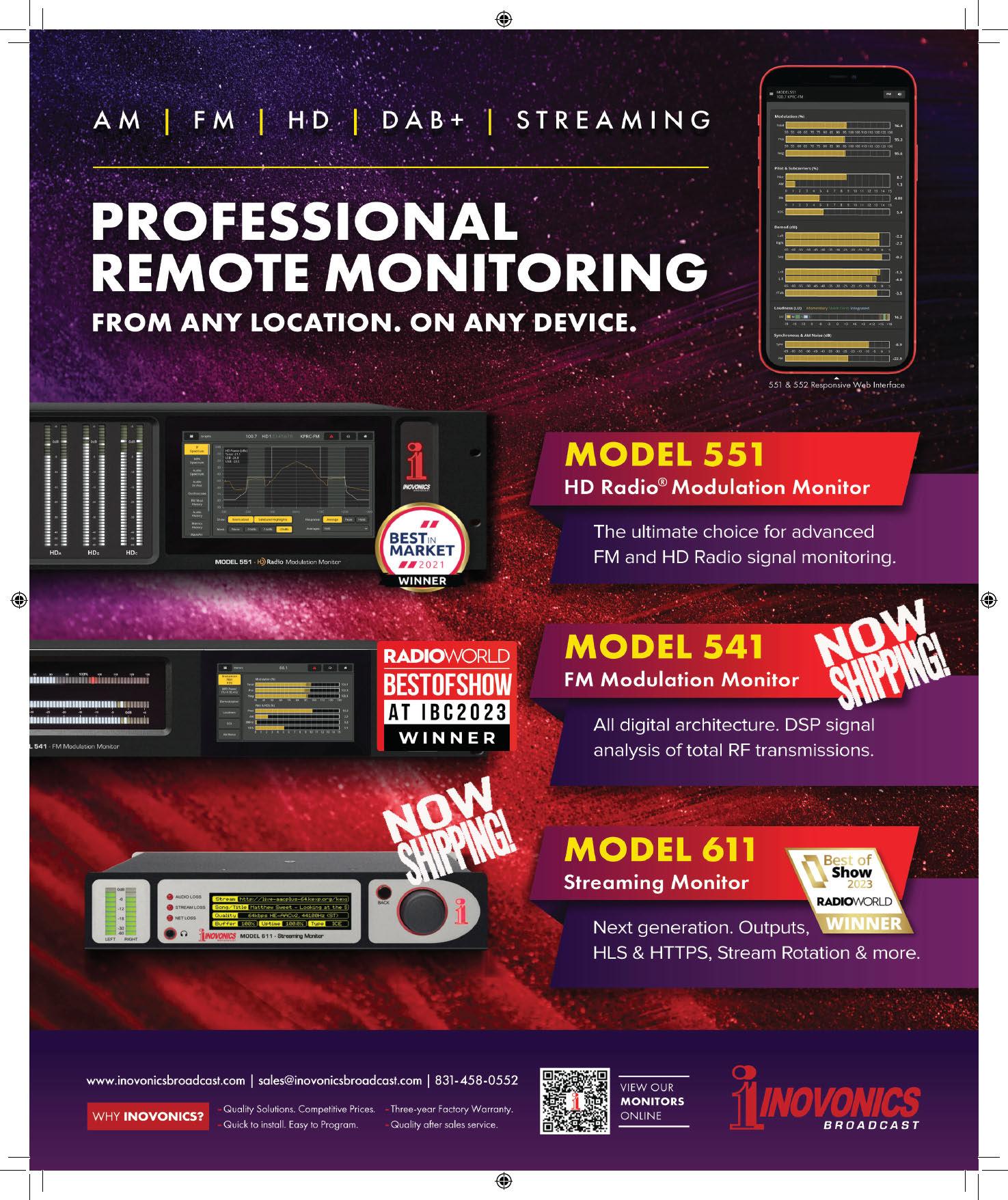
attack surfaces (i.e., no listening network ports) yet still allows KRYZ to receive crucial operational data from the tower so they can easily and remotely monitor their [site’s] health and status,” it said.
“Additionally, using ‘SSH No Ports,’ the station’s administrator can still access the network to administer and update the crucial network.” SSH No Ports is a technology that uses an encrypted control plane to initiate SSH connections without opening ports on your devices.
One of the Raspberry Pis is used as a jump box that allows administrators to use SSH No Ports to access and administer equipment in the shed including the other two Raspberry Pis. The second is used to process the digital audio stream using an audio tool. The third is used to monitor the transmitter’s health and status, and to send alerts if there are problems.
You can read a description of this project at https://atsign.com/blog/

under “Secure Your Radio Station With Networking 2.0.”
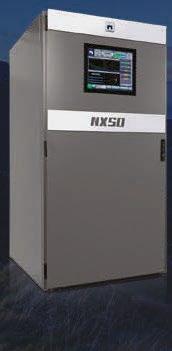
Dan’s busy browser
Frequent contributor Dan Slentz has been perusing the World Wide Web again and brings us several more useful discoveries.
The first is a cool neon-style LED “on air” sign that is powered by USB and costs under $20. Dan found it on Temu and says he can’t believe how bright the sign is. A 5VDC wall adaptor will power it. (It literally is a “cool” find because it generates very little heat.)


Dan says this would be useful at small studios, remote broadcast locations and podcast setups. Head to www.temu.com and search “neon on air light.”
Dan’s next find is appropriate for this time of year. It’s a web-based tool to predict sun outages and sun interference for geostationary-orbit satellites.
Using the app is straightforward. You pick a satellite from the list and select C or Ku band, then enter the antenna size and choose the season. Then double-click on your location on the map. A grid at the bottom will give you a window of time when you can expect sun outage.
Top Dan Slentz found this inexpensive on-air sign.
Above Snake Tray offers a variety of cable management solutions.
At www.satellite-calculations. com, scroll down to Sun Outage Prediction Tool.
Finally, if you need to route cables, check out the fun and interesting catalog of a New York-based company called Snake Tray. It provides a variety of cable trays, from simple and inexpensive to larger and heavierduty models. You can download all 100+ pages of the catalog in PDF form at www.snaketray.com.
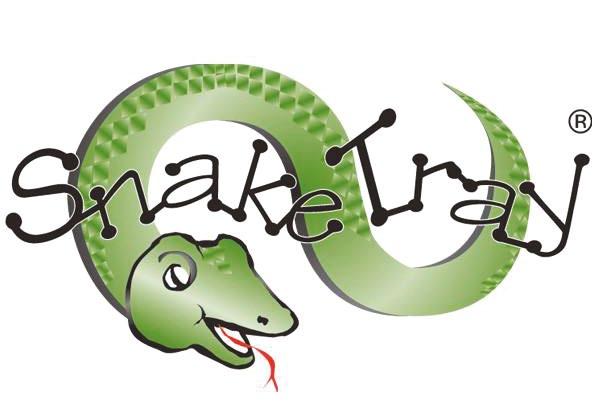
12 radioworld.com | October 11 2023 Work
bench
Writer
An easier, simpler way to proof antennas
Gregg
Last year the FCC changed its rules to make it significantly easier for FM radio broadcasters to verify their directional patterns.

The report and order gives FM and low-power FM applicants using directional antennas the option to verify their pattern with computer modeling performed by the antenna manufacturer. Previously, the rule required the performance proof of an FM or LPFM directional antenna to be verified by costly, time-consuming actual filed pattern measurement.
As recognized by Chairwoman Rosenworcel, more than a fifth of FM radio stations use directional antennas, but FCC rules required a very expensive and difficult method to prove the array by physical measurement.

Prior to the new rule, FM radio stations using directional antennas were either required to provide actual measurements of the radiated signal to verify their directional pattern utilizing a full-size mockup or scale model of the antenna. Both are expensive to complete. Further there were several difficulties with conducting the physical measurement, such as accurately replicating the installed antenna environment, including nearby structures, that could affect the radiated pattern.
A properly implemented computer model can take these factors into account and provide a more accurate and lessexpensive pattern verification.
Engineer qualifications
Initially, the commission proposed that the license applicant must provide details of the software tools used in modeling the antenna’s directional pattern, the process by which the
computer modeling was carried out and the qualifications of the engineer who designed, modeled and provided installation instructions for the directional antenna.
However, the commission was persuaded that this would be too cumbersome and concluded to allow license applicants to verify the directional antenna patterns by submitting results from computer models depicting the antenna’s performance generated by the manufacturer.
In reaching its conclusion, the commission noted that AM licensees almost always rely on antenna manufacturersupplied tabulations of the measured relative field pattern performed either on a full-scale test range or with a scale model of the antenna. It decided that allowing FM applicants similar flexibility would be appropriate here.
The commission explained that relying on the antenna manufacturer to validate directionality via computer modeling was unlikely to cause problems. Manufacturers are able to ensure the validity of the computer model and the accuracy of the results, and manufacturers can be relied upon to use engineers possessing the required expertise. Given the varying backgrounds of broadcast engineers, it declined to codify computer modeling qualifications, noting that, should a challenge arise, for example, in the nature of interference complaints, it would seek further information regarding the broadcaster’s model, including the qualifications of those who prepared and performed the modeling.
While there is no limitation on those who can perform computer modeling for AM and DTV directional antennas, the commission declined to grant similar flexibility to FM applicants. FM applicants will be required to use
What to know about computer-modeled proofs of FM DAs P. Skall Telecommunications Law Professionals PLLC
13 radioworld.com | October 11 2023 Radio Regulation
Walter Bibikow/Getty Images
manufacturer modeling because there are a greater number of FM stations, as compared to DTV stations using directional antennas, and it is not possible to subject FM directional antennas to continual verification through sampling, unlike AM directional antennas.
The application
Antenna manufacturers may use either commercially available modeling software or their own proprietary software provided it meets the requirements. FM applicants for a directional antenna are required to ensure the following information is provided for each option:
1. Commercial software: The manufacturer’s report must identify which commercially available modeling software the manufacturer utilized to verify the antenna directional pattern.
2. Manufacturer custom software: The submission must include a description of the software and the computational methods underlying the software sufficient to replicate the results if necessary.

Broadcasters must ensure that the model analyzes the antenna as mounted on their proposed tower or tower section. The digital model of the tower or tower section must include existing transmission lines, appurtenances, ladders, conduits, other antennas, and any other installations that could affect the directional pattern. The submission statement, which as noted below will be prepared by the engineer and submitted with the application, must also list and describe all such elements and structures included in the model.

In addition to information on the type of software, the application also must include:
1. A statement setting forth the name(s) and qualifications of the engineer(s) who designed the antenna, performed the modeling, and prepared the manufacturer’s instructions for installing the antenna.
2. A statement from such engineer(s) identifying and describing the software tools used in the model and the procedures used in running the software.
3. A certification that the software executed normally without generating any error messages or warnings indicating any problem with the inputs.
4. Verification of the accuracy of the pattern generated using the particular modeling software for each directional antenna model number or standardized series of elements.
5. A certification from the engineer responsible for installing the antenna that the antenna has been installed pursuant to the manufacturer’s instructions, and verification from a licensed surveyor, that the antenna is properly oriented.
Previously verified antennas
To promote efficiency and ease the burden on FCC staff, once a particular antenna model or series of elements has been verified by any license applicant using a particular modeling software, the commission will permit all subsequent license applicants using the same antenna model number or elements and using the same modeling software to cross-reference the original submission by providing the application file number.
Above Optimized simulations of an FM pattern study from antenna manufacturer Dielectric.
Interference complaints
The commission dismissed concerns from antenna manufacturer ERI that modeled pattern verification could lead to increased interference once installed, believing this was sufficiently addressed through modeling software verified by measurements requirements, but reaffirmed its policies regarding the need to address interference complaints or disputes.
Conclusion
FM license applicants now have the option of submitting computer-generated proofs of FM directional antenna patterns from the antenna’s manufacturer in lieu of measured pattern plots and tabulations, a far simpler and less expensive option.
Applicants may still submit measured relative field patterns rather than computer modeled patterns if they so desire, but the revised rules should ease the burden on FM directional applicants.
This column is provided for general information purposes only and should not be relied upon as legal advice pertaining to any specific factual situation. Legal decisions should be made only after proper consultation with a legal professional of your choosing.
Are you getting your SmartBrief? Radio World’s free e-newsletter arrives every workday. At radioworld.com, click “Subscribe,” then “Radio World” to sign up. 14 radioworld.com | October 11 2023 Radio
Regulation

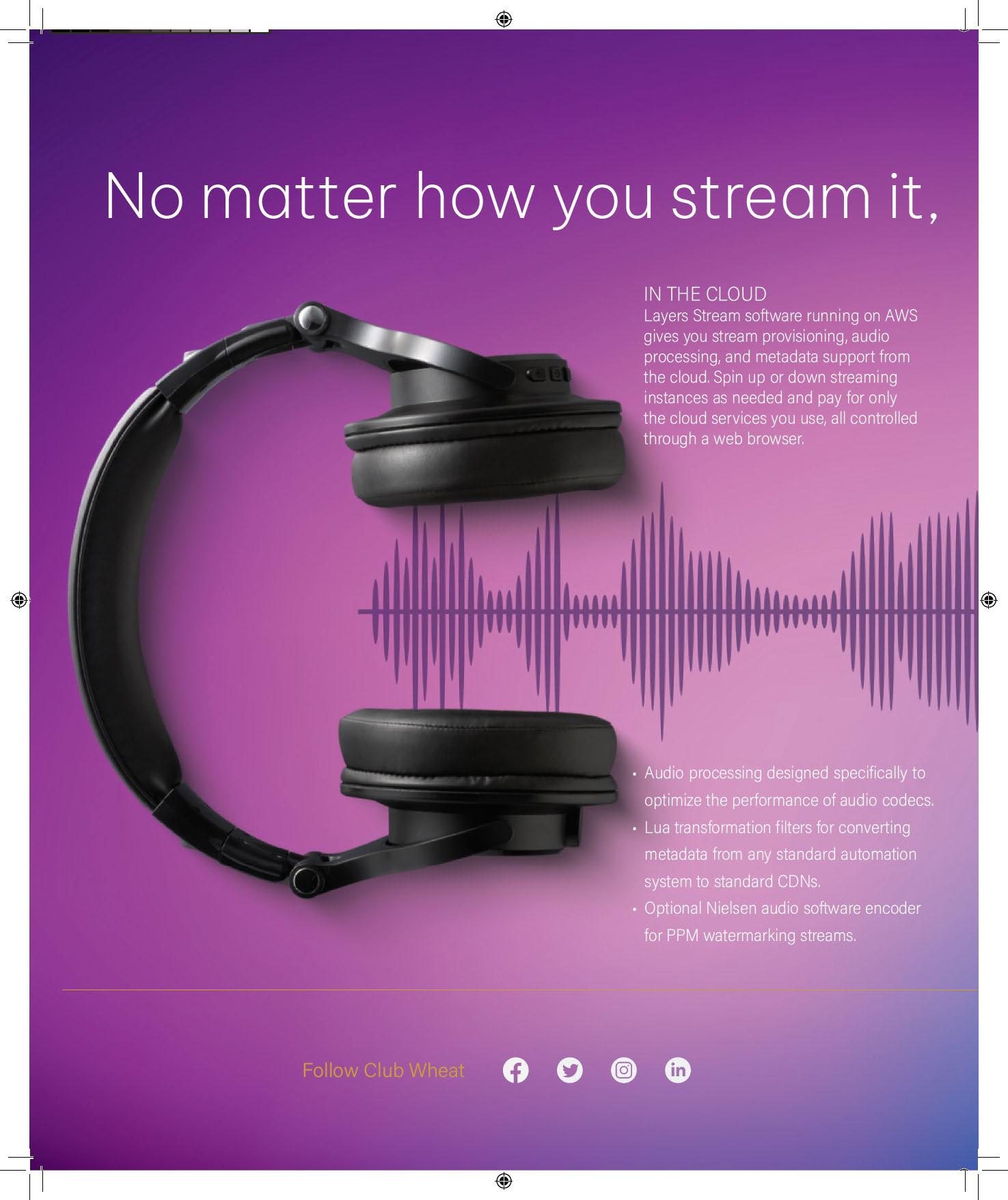
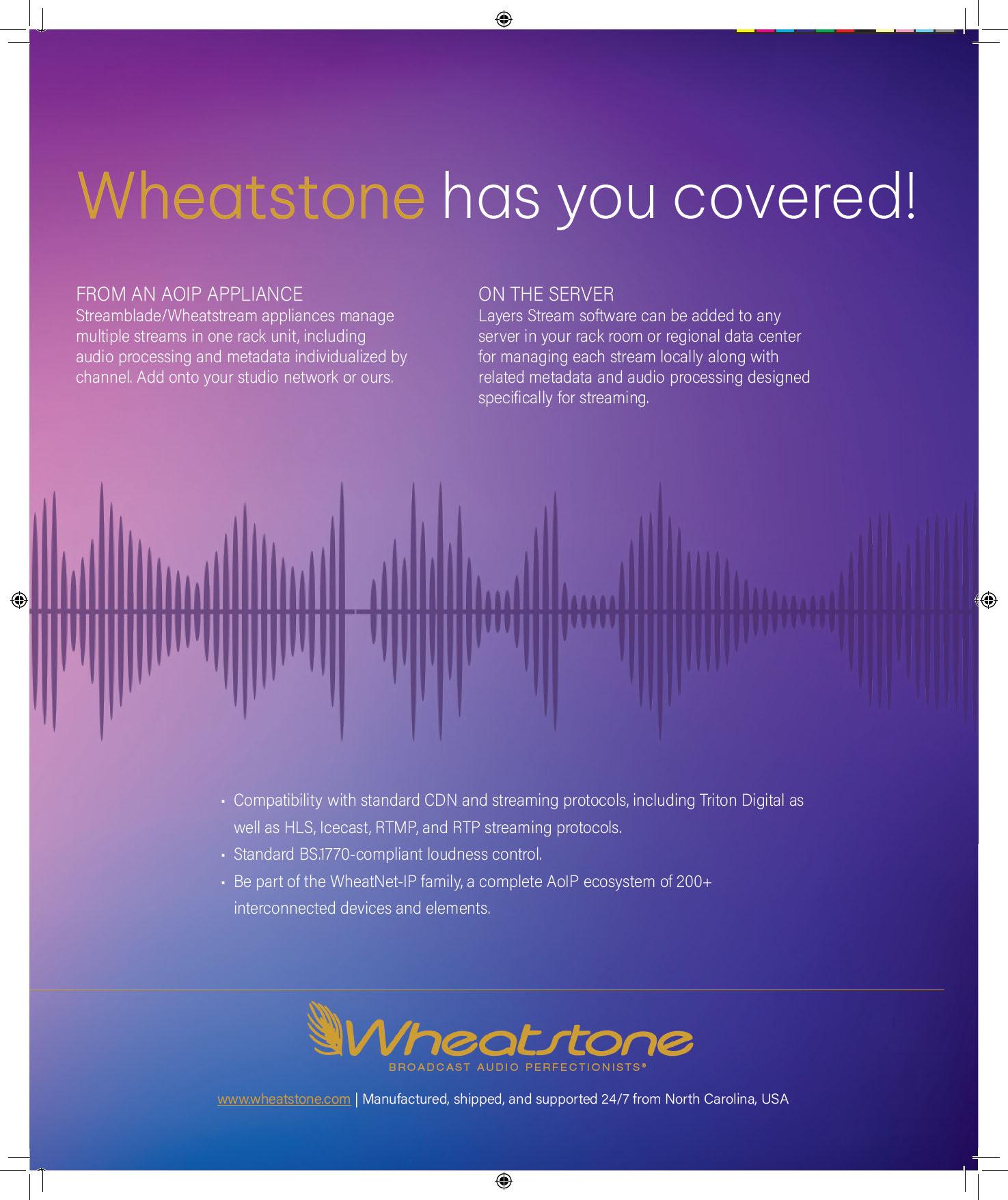 Writer Morgan Grammer
director
Writer Morgan Grammer
director

7 tips for better streaming
Rule No. 1: Make it easy for listeners to hear your station online

Having a high-quality, reliable stream is becoming ever more important as radio listeners become more tech-savvy and technologies such as DTS AutoStage bring streaming to the automobile, helping to extend the range of your radio station. Here are a few tips to ensure your stream is the best it can be.
Make your stream readily available. 1
Every week, I try to put myself in a listener’s shoes and take a few minutes to look around and see what other stations are doing, looking for good ideas and identifying things that just don’t make sense.
Right off the top, one of the things I look for is a station’s streaming links, and hopefully they are front and center on the website. I say “hopefully” because you’d be amazed at how some stations hide the link to listen on a back page, make you complete a form to get
to the “listen live” button or say “find us on TuneIn.” Well, I’m sorry to say, those things make the station a real “Tune Out” in my book.
HTML5 web players that you can integrate into your website, supporting AAC streams (or *gasp* MP3) are readily available. The #1 reason your listeners visit your website is to hear your station. Make it easy for them, so they might hang around and see what else you’ve been spending countless hours building for them.
Don’t forget a mobile app too, which can put your brand at someone’s regular fingertips, and even let them talk back to you.
Process your audio for TSL, not AQH
2I got the radio bug at a young age and have fond memories of annoying the local top 40 radio DJs. The ’80s and ’90s FM stacked processors of my high school years (Texar Prisms, CRL Matrix processors and heavily modified Optimods) are still fun to play
grinvalds/Getty Images 18 radioworld.com | October 11 2023 Streaming Tips
The author is
of engineering for Cox Media Group’s Tulsa cluster.

with, but they belong in the tinkering room, not “leveling the stream.”
Stream codecs hate clipped audio (especially that audio coming out of the back of an old FM processor), and audio should be processed for long listening sessions (we aren’t fighting a noise floor and have good dynamic range).


Your final encoded audio should be closely level-matched with the commercials inserted in your stream. I don’t like my ears bleeding when the super-loud “Sunday Sunday Sunday!” ad comes on, and your listeners won’t either. Use an audio processor built for streaming, or better yet, get a solution that does processing and encoding together in one (we use the Wheatstone StreamBlade at Cox Media Group).
Metadata matters: Check your spelling. 3 Thanks to that pesky smartphone, your listeners expect to see the title and artist of the song they’re listening to. This data should be coming out of your automation system, but is it correct?
We’re all guilty of typos and trade shorthand, but you don’t want your listeners questioning whether you learned how to spell, and they may not understand why the outcue or agency name in your automation system is showing up on their phone.
Your automation system or the PAD processing system you’re using for your RDS/HD Radio (you are showing title and artist on your OTA signal, right?) likely has a stream encoder-friendly output that can help fix some of these issues.
Make sure the commercials run on time: Metadata timing. 4

While we’re talking about metadata being correct, check that it’s being delivered in sync with the audio. Is your talk-station’s audio running through a profanity delay? If so, has the metadata been delayed by the same amount of time/buffer that the profanity delay holds?
Your over-the-air clients expect their commercials to run as approved, not upcut/downcut or airing in the middle of your host’s closing sentence, and you should be treating your stream with the same care.
Make sure the metadata is in sync with the audio that’s coming through the speakers, down to the millisecond, so you have seamless transitions between inserted commercials and your program audio. These adjustments can be made in your metadata processing system, and my favorite streaming encoder has that feature too. Sloppy transitions are annoying to the listener and don’t make you sound like the great broadcaster you are.
Is your stream “on the air”? 5
Are you monitoring your stream to ensure it’s not broadcasting silence, or checking to ensure the encoder is transmitting? Did your streaming service drop the connection, or are they having a problem?
You should be the first to know this, not finding out about it from your listeners who have already gotten frustrated enough to write you an email or send you a message on X.
There are some great hardware options out there that will monitor your stream, send email alerts and allow you to monitor your metadata too. If money is tight, an internet player like a Barix Exstreamer can be wired to a silence sensor, which will at least tell you “The stream is up and there’s audio.” If you’re a little craftier, a Raspberry Pi and
some freely available software packages can replicate the same solution for even less.
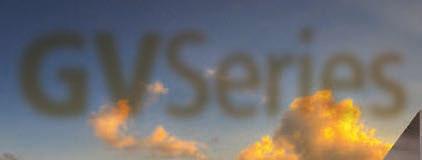

To MP3 or not to MP3 …

Despite being very long in the tooth, the venerable MP3 format continues to hang around in legacy devices and as a fallback in many smart speakers.
Looking at my own stations, many of our listeners are connecting with devices that can hear our AAC streams, and the AAC stream offers an audibly better listening experience than its MP3. That said, there are still a fair number of listeners connecting to our MP3 streams, enough that I’m not quite ready to toss that option out the window.
6
” Smaller Footprint GV30 GVSeries 3.5 kW – 88 kW Digital/Analog FM nautel.com/GV 20 radioworld.com | October 11 2023 Streaming Tips
“You’d be amazed at how some stations hide the link to listen on a back page, make you complete a form to get to the ‘listen live’ button or say ‘Find us on TuneIn.’
Present both options, if you’re not using an embedded web player, and your app ought to support both (start with an AAC connection first, and failover to MP3 if something goes wrong).
Choose a CDN carefully, and make sure you have backups
All this wonderful work you’re doing to make your stream the best it can be is ultimately at the mercy of your CDN partner to get it to your listener in a reliable way.
How are you getting your encoded audio to the CDN? Are there backup servers in case one datacenter goes down? Do you have a backup encoder in case your primary goes on vacation?
Legacy streaming encoders often use basic HTTP connections to get the encoded audio up to the server/ CDN. These connections have little redundancy, and simple internet “blips” in the connection between your encoder and the CDN are magnified to all your listeners.
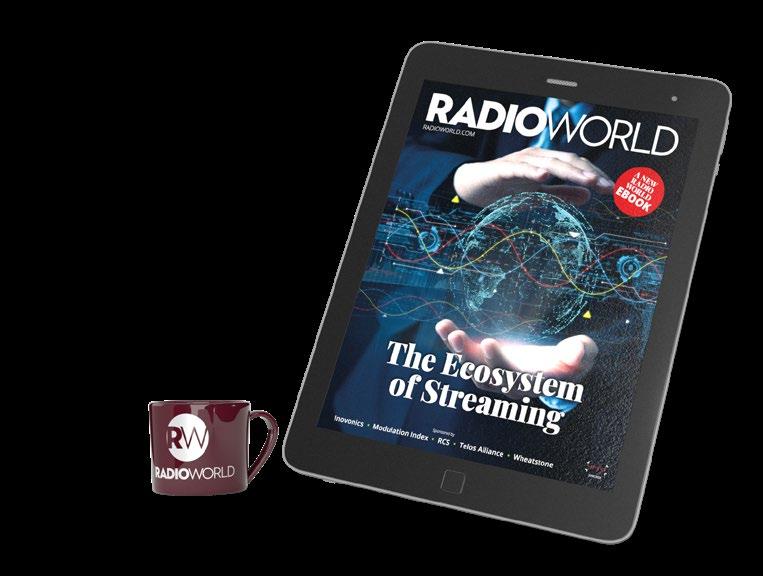
Consider upgrading to at least an RTMP (Real-Time Messaging Protocol) connection, which was built for streaming audio and video, and offers better reliability and buffering for the busy and imperfect internet. Similarly, check with your CDN to see if they have redundant servers in a geographically disparate datacenter, and if you’re able to send a live stream to both datacenters. This simple backup measure will help ensure if one datacenter goes down (and they do from time to time), you’re not out of commission for hours on end waiting on someone else to fix things. Similarly, if you can afford it, have a backup encoder in your technical plant, ready to go when you need it. Just like your backup transmitter for your OTA signal, you don’t want to be down because a hard drive quit spinning, or a power supply gave up.
The author oversees technical operations of five radio stations including a news/talk on a 50 kW AM and associated FM signal. He also plays an important role in Cox Media’s streaming deployments. He has been interested in streaming since his days attending college and setting up a RealNetworks RealAudio server for the campus student-run radio station.
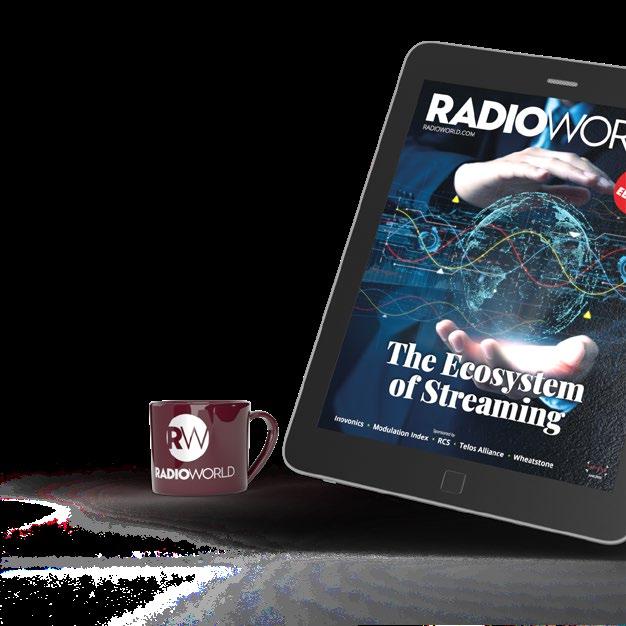
Midwest Rebuilds at West Pines
In December 2021, Midwest Communications Inc. lost a 500-foot tower serving its 50 kW Class B FM station WMGI in Terre Haute, Ind. An 18-month project led to a new tower, building and transmitter at the West Pines Tower Site, plus the addition of a second Class B station. ERI and Nautel were among the major vendors. Read our interview with Chief Engineer Kevin Berlen in “Great New RF Installs” at radioworld.com/ebooks

Ecosystem of Streaming
7
radioworld.com/ebooks 21 radioworld.com | October 11 2023 Radio World
The
Writer
Donna L.

New program nourishes high-school interest in radio

Two state associations partner to launch the High School Radio Project
It’s no secret that the percentage of young people who listen to radio has been on the decline for a decade or more. And while surveys repeatedly show that teens listen to music for at least two hours a day, they no longer tend to listen on terrestrial radio unless they’re in the car with their parents.
So in a world ruled by YouTube, iTunes and Spotify, can teens learn to believe that radio is kind of cool after all?
That was the challenge Jim Timm, president and executive director of the Omaha-based Nebraska Broadcasters Association, decided to take on. He and members of NBA’s board of directors wanted to nurture the next generation of broadcasters. But how?
Timm recalled that the association had conducted a media camp for high school students and that radio was one of the options. He remembered that the students resisted — “Radio’s lame; nobody cares about it,” one said — but that once they started broadcasting, they had so much fun that it changed their perception.
the songs, record news and sports features, and be heard by a potential audience all over the country. The stations would use automation but could go live in certain circumstances. The state association would lend the gear and software to a school; after students’ time with the project ended, the school would ship the gear to the next participating school.
In 2021 Timm ran the idea past Jordan Walton, executive director of the Massachusetts Broadcasters Association, whom he’d met through the National Alliance of State Broadcasters Associations. “I’ve known him for nine years,” Timm says, “and I respect his opinion.”
Walton liked the idea and wanted to collaborate. “So many students today are not even aware of broadcasting,” Walton says. “We want them to see how much fun doing radio can be. Maybe a few of them will [decide] to be involved with media, where they weren’t before.”
Above Students at Westfield Technical Academy in Massachusetts are participating in “WTA Radio” this year.
Timm believed this experience could be replicated. He envisioned a project in which high schools could offer students the opportunity to learn how to broadcast via online streaming.
The idea was to partner with local schools to create stations on which students would choose and announce
Thus the initiative became a joint project of two state associations. Timm and Walton began meeting weekly via Zoom. Their work developed into the High School Radio Project.
They chose the online platform (Live365), music scheduling software (MusicMaster) and automation software (PlayoutOne); and they purchased audio broadcast equipment from BSW, including a Rodecaster Pro audio mixer, two microphones and all necessary
Halper
22 radioworld.com | October 11 2023 High-School Radio
Associate professor of communication and media studies at Lesley University, former broadcaster and consultant. She was inducted this year into the Massachusetts Broadcasters Hall of Fame.
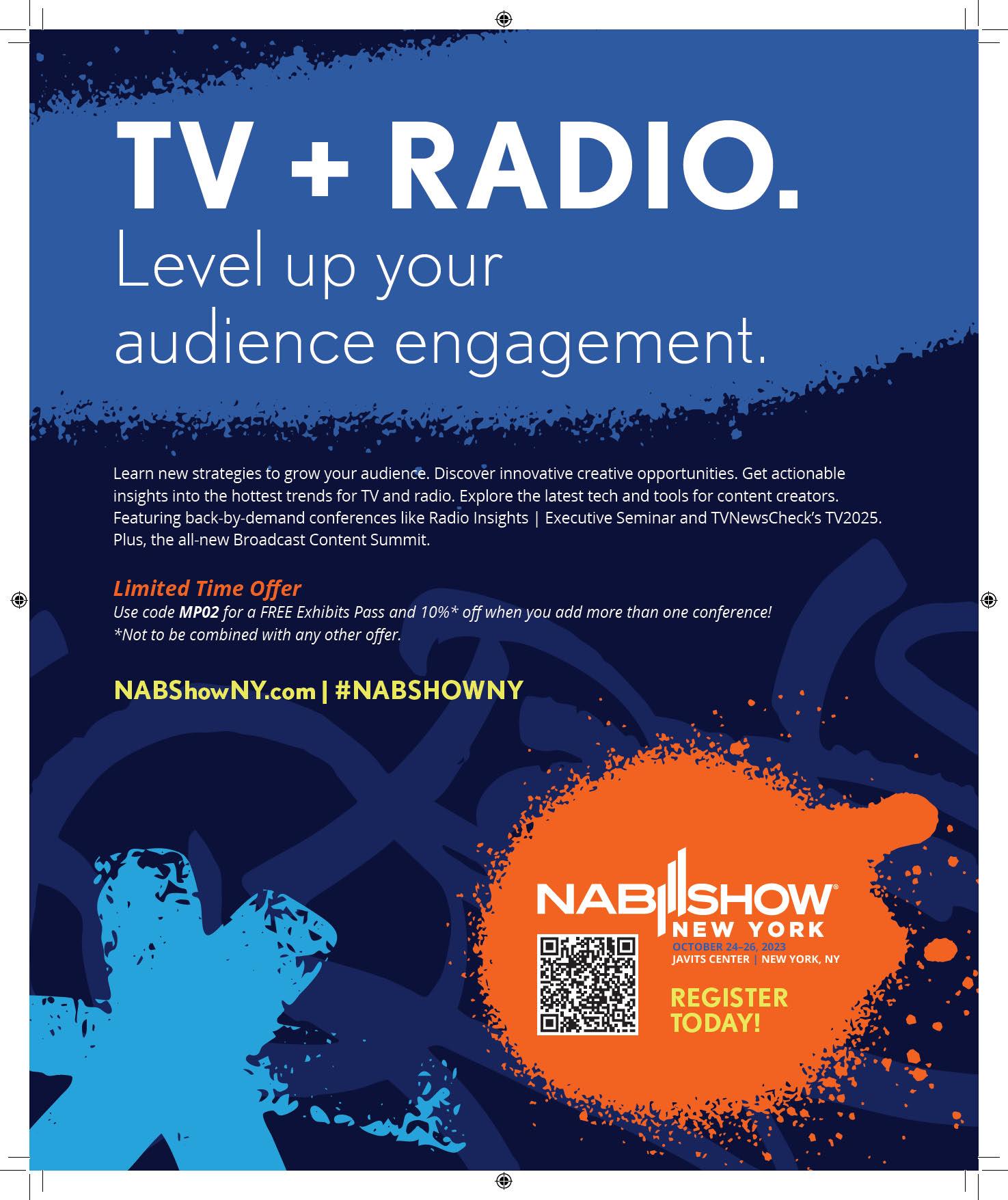
High-School Radio
cables. They decided they would offer schools a choice of music libraries: alternative rock, country, class rock and top-40. They also provide Benztown Branding to create promotional content and a guide to assist the teacher.
Each association funded its respective radio project, with hard costs in the first year running about $10,000 in each state. Annual costs to operate each station is another $5,000 or so.
The schools don’t pay anything to participate. The school must provide an internet connection, a PC that can connect to the mixer via USB, audio editing software like free Audacity, and classroom time.

The streams are heard on Live365, the HSRP website and Alexa skills.
Good fit
To pilot the project in Nebraska, Timm thought of a high school teacher named Mark Hilburn, who taught at Millard West High School in Omaha. He is an awardwinning journalism teacher and the former president of the Nebraska High School Press Association. Given Hilburn’s love of media, Timm believed he would be a good fit.
“He started out with seven students, five boys and two girls,” Timm recalls, “and worked [radio broadcasting] into the curriculum. He taught how to use the software and even how to do news.” The station debuted in January with the name “The Uproar.”
Hilburn says he had no problem getting students interested. “I told them they could be the first in the state to do a high school radio station.” And once they learned the equipment, which they found user-friendly, they couldn’t wait to participate. “They loved being hands-on, creating the broadcasts.”
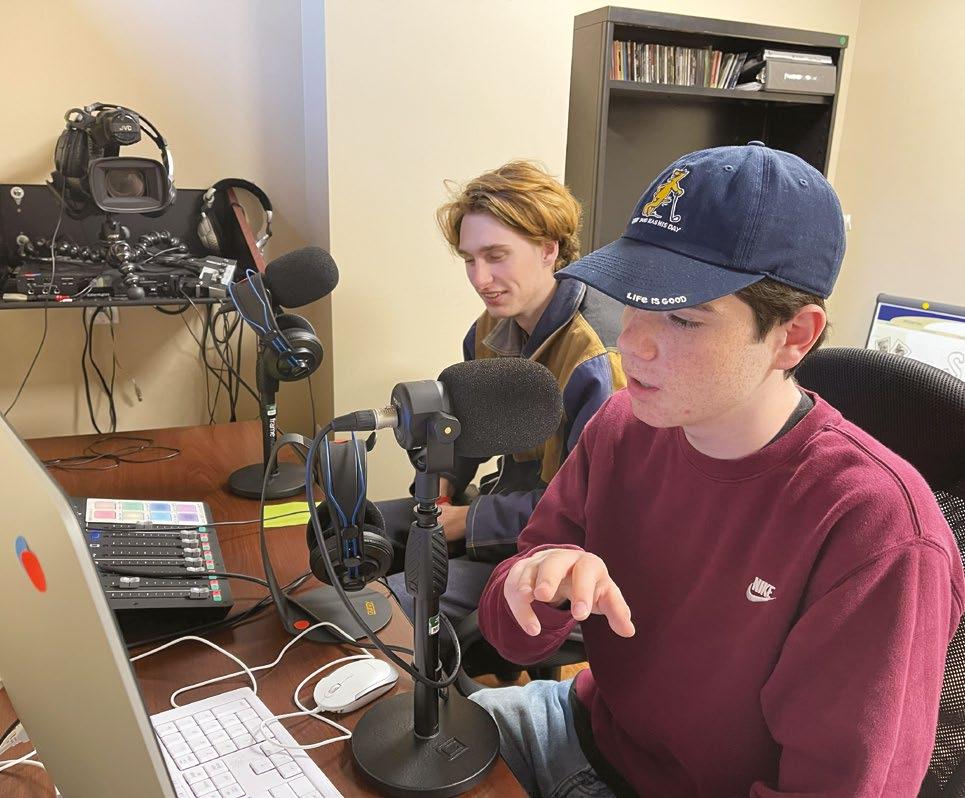

The more programs they put together, the more enthusiastic they were. “The students liked hearing their
voices on the station. And some of the [other] teachers began playing the station in their classroom,” Hillburn said.
Students chose and announced the songs and created reports about school news. And while software gave students the flexibility to record breaks in advance, students also wanted an opportunity to broadcast live. In May they went on the air live for an hour, and it was well-received at the school. “We’d like to do some more live programs, including sports,” he said.
Hilburn benefited from Timm’s guidance and feedback. Also valuable was support from long-time Omaha program director and announcer Kurt Owens. He collaborated with Timm and Walton to “create a series of video tutorials, as part of the training provided to students and teachers,” Timm said. Those are available under a training dropdown at www.highschoolradioproject.org.
The videos are short, designed to help students to learn the basics of such things as recording and loading the audio or building a clock in MusicMaster. Once the station was up and running, Timm made sure Hilburn and his students got frequent support.
“Kurt visited the Millard West classroom with me on a few occasions, providing veteran coaching and instruction to the students in real time.”
Owens enjoyed his experience working with high schoolers. “I had a chance to work on voice tracking with each of [the students], and it was great to see them excited about the idea of radio, and that someone might be listening to them … Of course as with most things there were a few who took to the radio project right away and turned into great leaders. But by the time we did the live show, the whole class was excited and all participated.”
Hands-on learning
In Massachusetts, the program ran last year at Watertown High School near Boston, guided
24
Left Junior Logan Moseley edits audio for “The Uproar” at Millard West High School in Nebraska. Right Watertown (Mass.) High School seniors Michael Corbett, foreground, and Henry Broadstone record a break for their lunchtime show “Alternative Lunch with Henry and Mike” in the spring of 2023.
by media teacher Todd Robbins, a veteran local sports broadcaster who had helped build up the number of media courses offered at the school.
Robbins spoke with Radio World this summer about the experience.
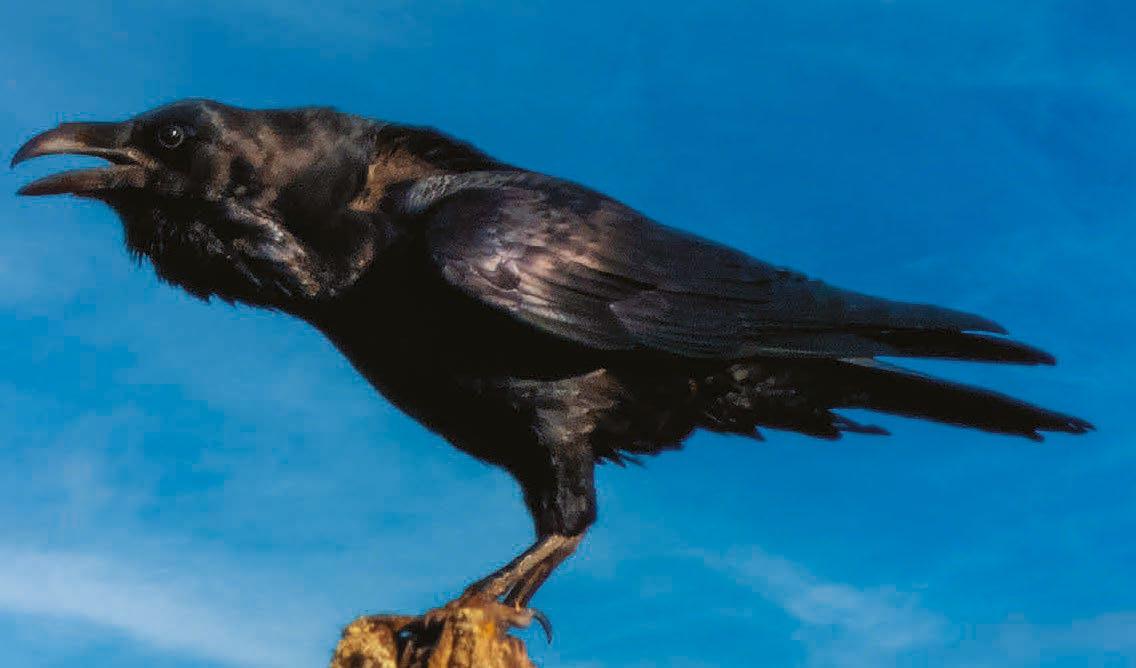
In the beginning, he had about 12 students participating in the online station. “I was very impressed with what Jim and Jordan put together. The software was similar to what you’d find at a [typical] radio station.”










Three seniors were especially interested. “They did the voice-tracking. They ran the programs.” Gradually, more students got involved, and all received hands-on training.
His “Radio and TV News” course dovetailed into the project. “I let the students [in that class] produce the newscasts.” And because the students were choosing the songs, doing the announcing and producing the content, Robbins said they seemed invested.

“My students wanted to listen to it. And the interest increased as we promoted it. It was a 100% success.” Robbins said the project teaches students about decision-making, how to handle mistakes and how to learn by doing. “If students can take with them what they learned from the High School Radio Project, these are marketable skills.”
The program has concluded at Watertown High, and Robbins has moved on to another job. Westfield Technical
Michigan Campaign Targets Youth
The Michigan Association of Broadcasters recently launched an innovative industry recruitment campaign called “Be There.” It is designed to provide young people a look at broadcast careers and an understanding of the ecosystem of a station, whether on-air or behind the scenes.




The marketing effort includes television and radio spots, social media, printed materials and a long-form video to be shown at high schools and colleges. There are detailed descriptions of more than a dozen media careers including reporters, anchors, meteorologists, hosts, engineers, I.T. professionals, sales, music directors, editors and traffic managers.



For info visit BeThereMichigan.com.
Academy in Westfield, Mass., is running the radio project this year, and Walton said a station is in the works at Thurston High School in Redford, Mich., through the Michigan Association of Broadcasters.




Walton believes the project promotes the value of audio storytelling, as well as introducing students to the possibility of careers in broadcasting. The project “gets kids to see how much fun doing radio can be.” He hopes the project will continue to spread to other schools. “For me, the takeaway is that students can still get excited about broadcasting if given the opportunity.”

25 High-School
Radio
Trust me, I’m AI

Beware being sucked in by the notion of the Next New Thing

Trust is foundational to broadcasting. If you are to be highly successful, your audience must find your on-air talent credible, relatable and authentic.
Anecdotally, I’ve found that in our postpandemic world, skepticism and cynicism are running hotter than ever, especially when it comes to content and the people who are presenting it.
While I’ve been aware of the trust factor for decades, I’ve noticed it has recently come much more to the forefront concerning relationships, influencers, social media and onair broadcast talent.
And now? Artificial intelligence, the latest of tech breakthroughs, is proving a significant element that may affect the way our audience relates to our content.
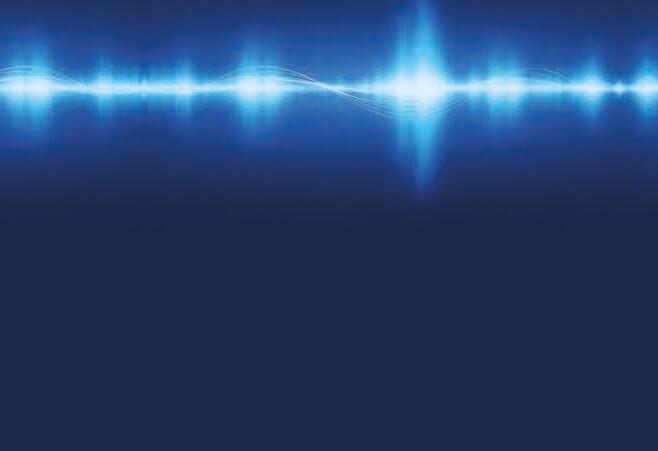
We’re about 10 minutes into the long game of how AI is changing our world.

Already, social scientists are gamely evaluating its impact. How people perceive AI is important both in the way we use it on-air and even in the way we talk about it.
If you’re considering AI as a substitute for human talent, or even as an ongoing novelty act, take a look at a new Mitre-Harris Poll. One of the key findings of the September survey is that Americans have a general distrust of artificial intelligence. Only 48% believe that it is safe and secure.
It looked at feelings about the use of AI as a tool for providing entertainment recommendations on streaming services, facial recognition on personal devices and targeted advertising on social media. Not surprisingly, this study does find generational attitude differences.
Rob Jekielek, managing director of the research, says, “A strong majority of Gen Z and millennials are comfortable with AI usage. In contrast, across those examples, boomers are 20–30% less comfortable with AI usage, with only a minority comfortable with use of AI for facial recognition on phones and personal devices (37% comfortable) and
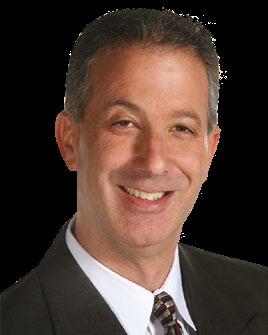
nautel.com/HD HD MULTICAST+ Combined Importer/Exporter with optional Orban audio cards
Mark Lapidus
Veteran multiplatform media executive with 30+ years’ experience creating broadcast, digital, social and mobile storytelling content, consumer marketing and branding.
26 radioworld.com | October 11 2023 Promo Power
Jackie Niam/Getty Images
targeted advertising on social media (29% comfortable).”
Another noteworthy stat: 82% of Republicans, 87% of Democrats and 85% of independents are in favor of efforts by government, industry and educational institutions to ensure that artificial intelligence is safe.
I strongly suspect that stations using AI as on-air talent are vulnerable to attack from competitors who can point out that they themselves would never eliminate someone’s livelihood with a robot that sounds soulless. It may be a leap to conclude from the Mitre-Harris Poll that open-minded, younger audiences are cool with new AI DJs, but I’m sure we’ll hear the feedback before long.

This notion of the Next New Thing reminds me of something I’ve witnessed many times. On-air talent with longevity and decent ratings is extremely difficult to replace. A common mistake among new program directors is to jump in and replace tenured talent with a shiny new personality. This fails more often than it works, and it

Above A Mitre-Harris Poll survey listed top concerns about AI including cyberattacks, identity theft, sale of personal data and a lack of accountability for those using AIpowered tools.
has been the death of many a longstanding franchise in a format. Could AI be much different, especially after the notoriety has worn off?
I couldn’t help myself: I queried ChatGPT as to the likelihood of an AI DJ building tenure and trust. It gave me seven very good reasons to trust an artificial voice. Of course it did. How humans will answer the question is still undetermined.
Email the author at marklapidus1@gmail.com or send a letter to the editor to radioworld@futurenet.com.
AI REPLACING ME AT MY JOB (AMONG THOSE EMPLOYED) 52% AI BEING USED IN MALICIOUS CYBERATTACKS 80% AI BEING USED FOR IDENTITY THEFT 78% NOT BEING ABLE TO HOLD THOSE USING AI ACCOUNTABLE FOR THEIR ACTIONS 76% AI BEING USED TO HARVEST AND SELL MY PERSONAL DATA 76% AI BEING USED TO CREATE DECEPTIVE POLITICAL ADS 74% THE LONG-TERM EFFECTS OF AI ON HUMAN COGNITION AND THINKING PROCESSES 70% THE LOSS OF HUMAN TOUCH IN COMMUNICATION DUE TO AI 69% UNFAIR DISTRIBUTION OF AI CAUSING HARM TO DISADVANTAGED POPULATIONS 66% UNFAIR DISTRIBUTION OF BENEFITS AND ACCESS ACROSS POPULATIONS 64% Concerned (very/somewhat)
27 radioworld.com | October 11 2023
How concerned are you, if at all, about the following related to AI offerings like chatbots, image generators and facial recognition tools?
CHIEF ENGINEER (North Country Public Radio)



North Country Public Radio, an NPR affiliate, seeks a Chief Engineer to manage and maintain our network of 34 FM facilities (2 main stations, 14 repeaters and 18 translators) well as our studio and radio automation equipment. The successful candidate will have a wide variety of technical skills and experiences in the broadcast engineering field and will become a valued member of a team at an awardwinning station known nationally for innovation and excellence.
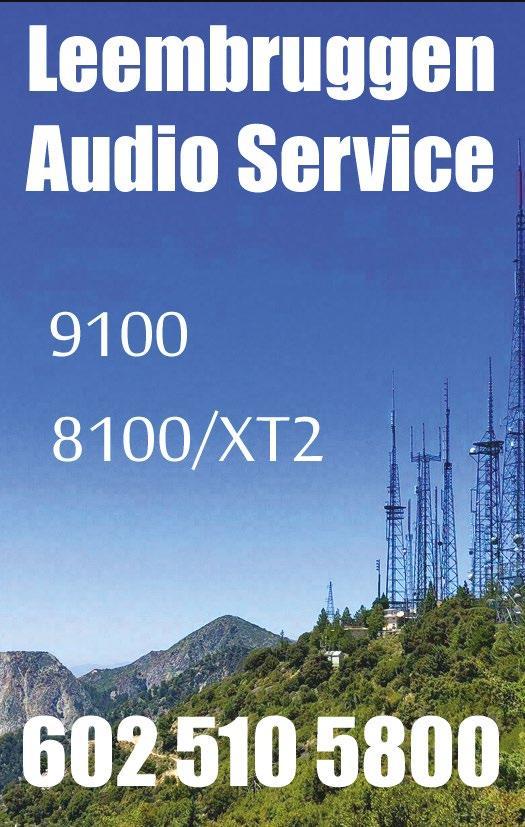
To view the complete position description, including minimum qualifications required, as well as application instructions please visit: http://employment.stlawu.edu. All offers of employment are contingent upon the finalist successfully passing a background (including criminal records) check. North Country Public Radio is an Equal Opportunity Employer.
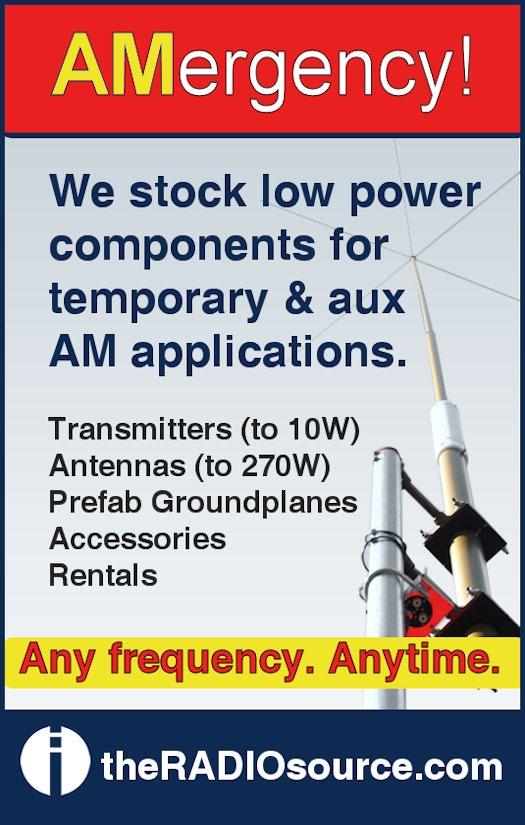
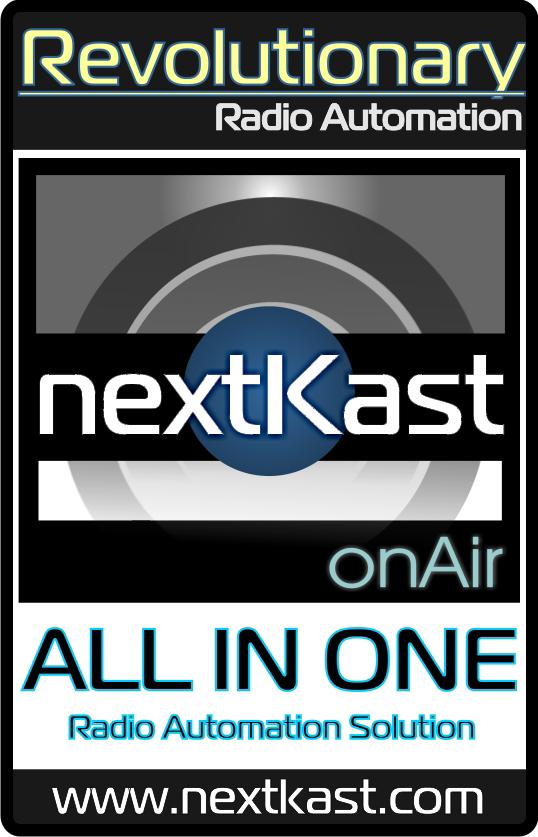



28 radioworld.com | October 11 2023
That’s a cool tower
I’ve enjoyed seeing the photos submitted recently. Since you asked for submissions, I thought I would pass along this winter photo from last year of the Rib Mountain Tower in Wausau, Wis.

This is the transmitter site for our stations WHRM(TV/FM) as well as our office. It is also the site for several other broadcast stations as well as NOAA Weather Radio and numerous other communications facilities.
Phil Langston Media Telecommunications Technician Educational Communications Board, North Central Region Wausau, Wis.
29 radioworld.com | October 11 2023 Readers’ Forum
that the AM band remained a player in future cars was decades before the cars of the future were created. Fail.
Paul Shinn Sonora, Calif.
A matter of commitment
Losing AM radio in cars is on par with the evaporation of small-town newspapers across the country.
It’s just too late to save AM in cars
It has been with great interest that I’ve read about carmakers dropping AM reception capability in new cars, particularly EVs, and about the introduction of the “AM for Every Vehicle” Act.
The reason most often cited by makers of electric vehicles is interference from on-board systems to AM band reception. The truth is we have ourselves to blame.
The assault on AM band purity predates the popularity of electric vehicles by decades. The onslaught of cheap switching power supplies in consumer electronics, RF noise-producing computers and personal devices, and the absolute lack of any care given to protecting the spectrum, are incompatible with AM quality.
For far too long, consumers, manufacturers, the NAB and even the FCC did not fight to protect the band. It seemed nobody cared whether new fluorescent lights (remember those?) caused so much noise that they even affected reception in neighbors’ homes. Nobody took up the fight to keep the band clean and make noise-free AM reception even somewhat possible in high-density housing areas. Nobody seemed appalled at this complete disregard for the usefulness of the band in the future.
Now comes legislation that would create an AM mandate for cars. But it relies on the same tired, lame excuse that the AM band is somehow going to be the only thing that stands between the public and certain death in some emergency scenario.
Sen. Ed Markey has said, “Broadcast AM radio is an essential part of our emergency alert infrastructure, but … far too many automakers are ignoring the critical safety benefits of AM radio.”
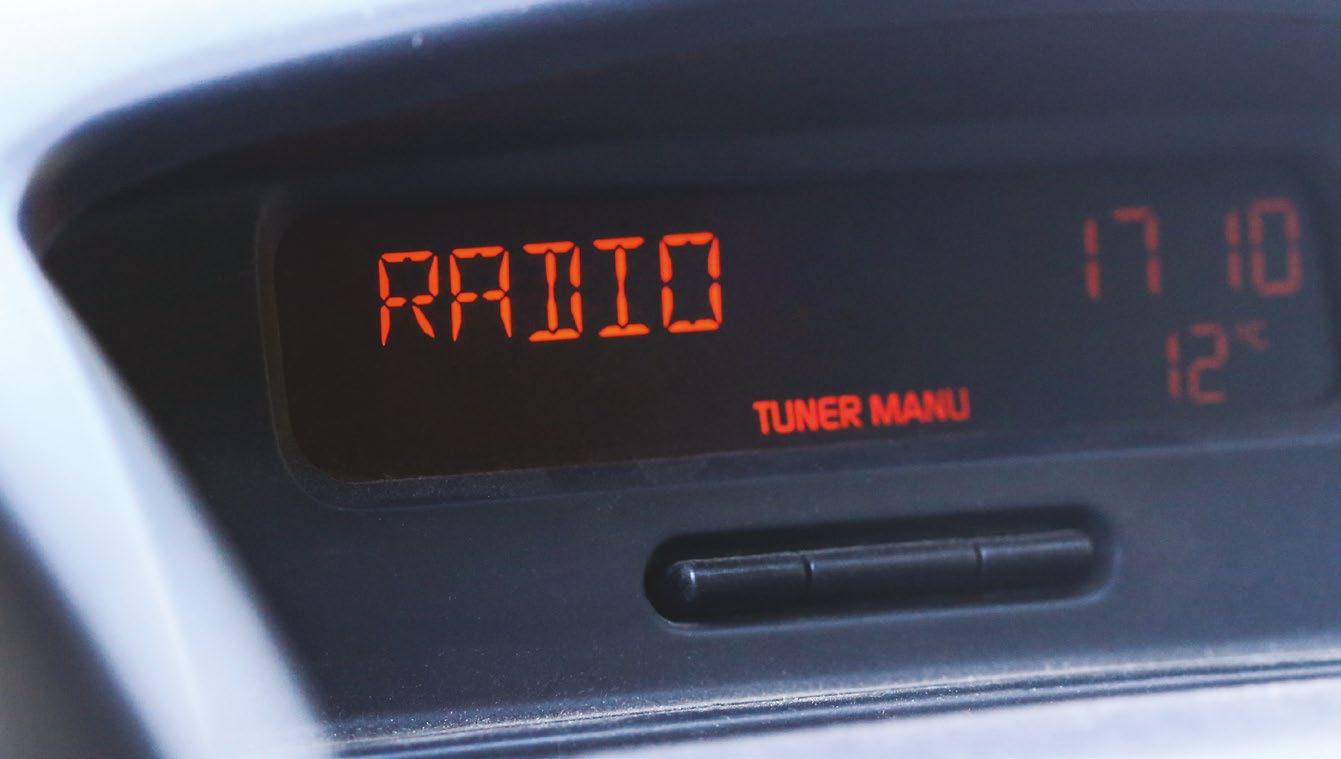
That statement was somewhat true 30 years ago, my friend. Nope, you’re too late. The genie was let out of the bottle and now you can’t get it back in, no matter what. The time to ensure
How to submit Radio World welcomes comment on all relevant topics. Email radioworld@ futurenet.com with “Letter to the Editor” in the subject field.
Considering the radio monopolies created with the 1996 Telecommunications Act, we should be looking at this not as losing AM, but losing dozens of radio frequencies once available, and the “marketplace of ideas” fading away.
AM radio fidelity is wanting, but tech improvements are possible. It is a question of priorities, and the iHeartRadio types do not care, owning hundreds of stations. Thanks, Bill Clinton, for signing that horrendous law and allowing this nightmare to unfold.
If we lose AM, corporate radio should lose a corresponding number of remaining FM radio frequencies to small-time (“mom and pop”) owners. Congress could take such action, but don’t hold your breath.
Pete Simon
Unhappy with HD
As reported by Radio World, Xperi issued a press release recently based on survey data from more than 2,900 U.S. car owners and leaders (“Xperi Survey Crowns AM, FM Radio as Most-Used In-Car Feature”).
Sure, folks still listen to the radio in cars. I have to point out that the survey did not detail how many reported only listening to analog and not HD Radio stations. Don’t you think that question was also asked, but the results might have been omitted from the press release because they didn’t fit the narrative the guys at Xperi have been spreading about a high level of HD-capable radios in the new cars?
Listeners don’t care about HD service from stations that play too many commercials and pick the wrong songs to play based on money and not good music. They would be upset if they knew how the HD signal was jamming many smaller adjacent stations. It is past time for this jamming signal to be shut off or at least make them put it on their own channel and not on the top of two other stations’ channels.
Brad Johnson Modesto, Calif.
30 radioworld.com | October 11 2023 Readers’ Forum
GoodLifeStudio/Getty Images
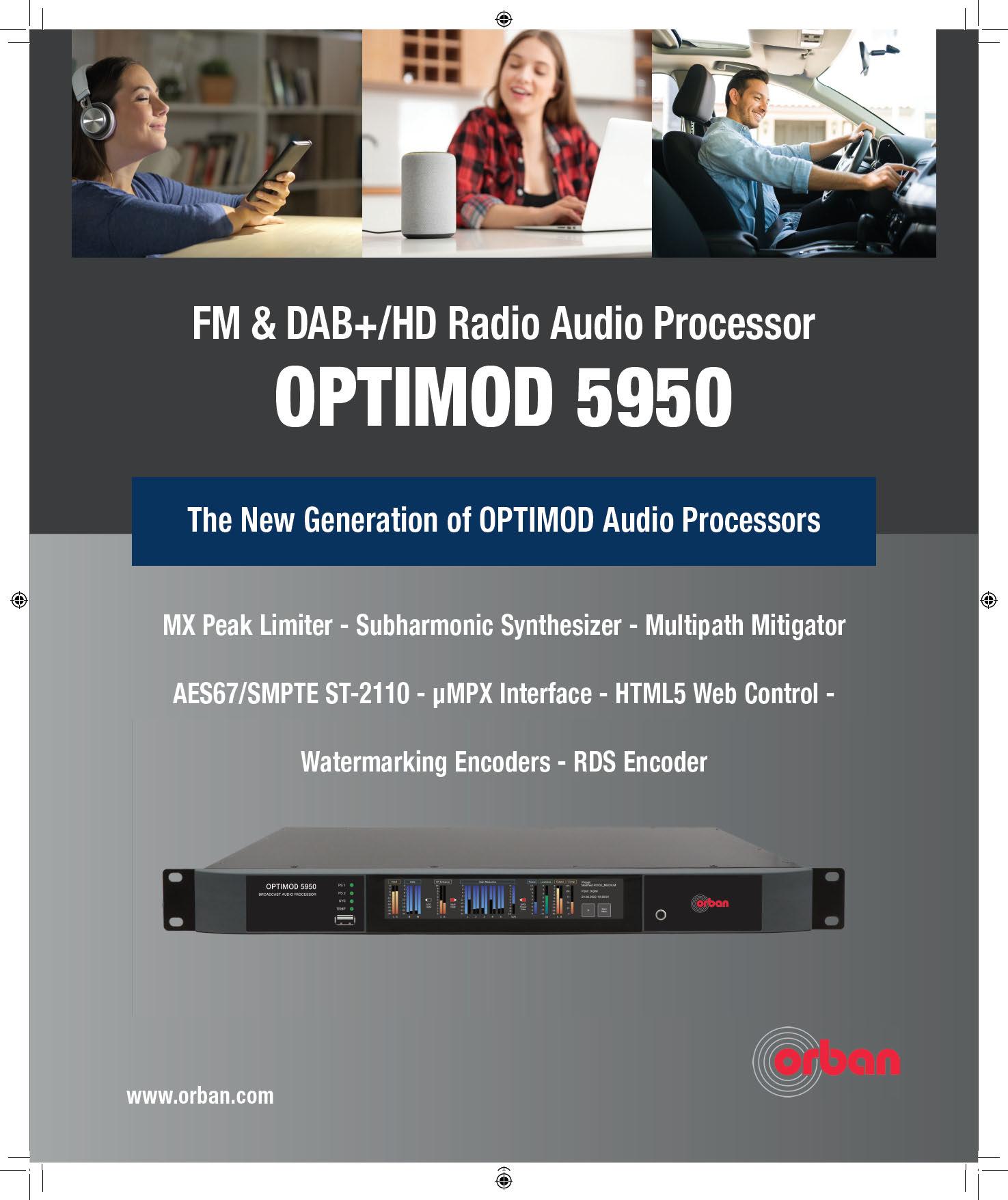

9000
































 John Bisset
John Bisset














 Writer Morgan Grammer
director
Writer Morgan Grammer
director

























































